Xeriscaping transforms water-thirsty landscapes into stunning, sustainable gardens that thrive with minimal irrigation. This revolutionary landscaping approach combines drought-tolerant plants, strategic design elements, and water-wise techniques to create beautiful outdoor spaces that reduce maintenance while enhancing curb appeal. Whether you're facing water restrictions, high utility bills, or simply want an eco-friendly garden, xeriscaping offers endless creative possibilities. From succulent container gardens to Mediterranean herb spirals, these water-smart designs prove that conservation and beauty go hand in hand. Today's xeriscape ideas blend functionality with aesthetic appeal, creating landscapes that support local wildlife, reduce environmental impact, and provide year-round visual interest through diverse textures, colors, and forms.
1. Xeriscape Succulent Container Garden
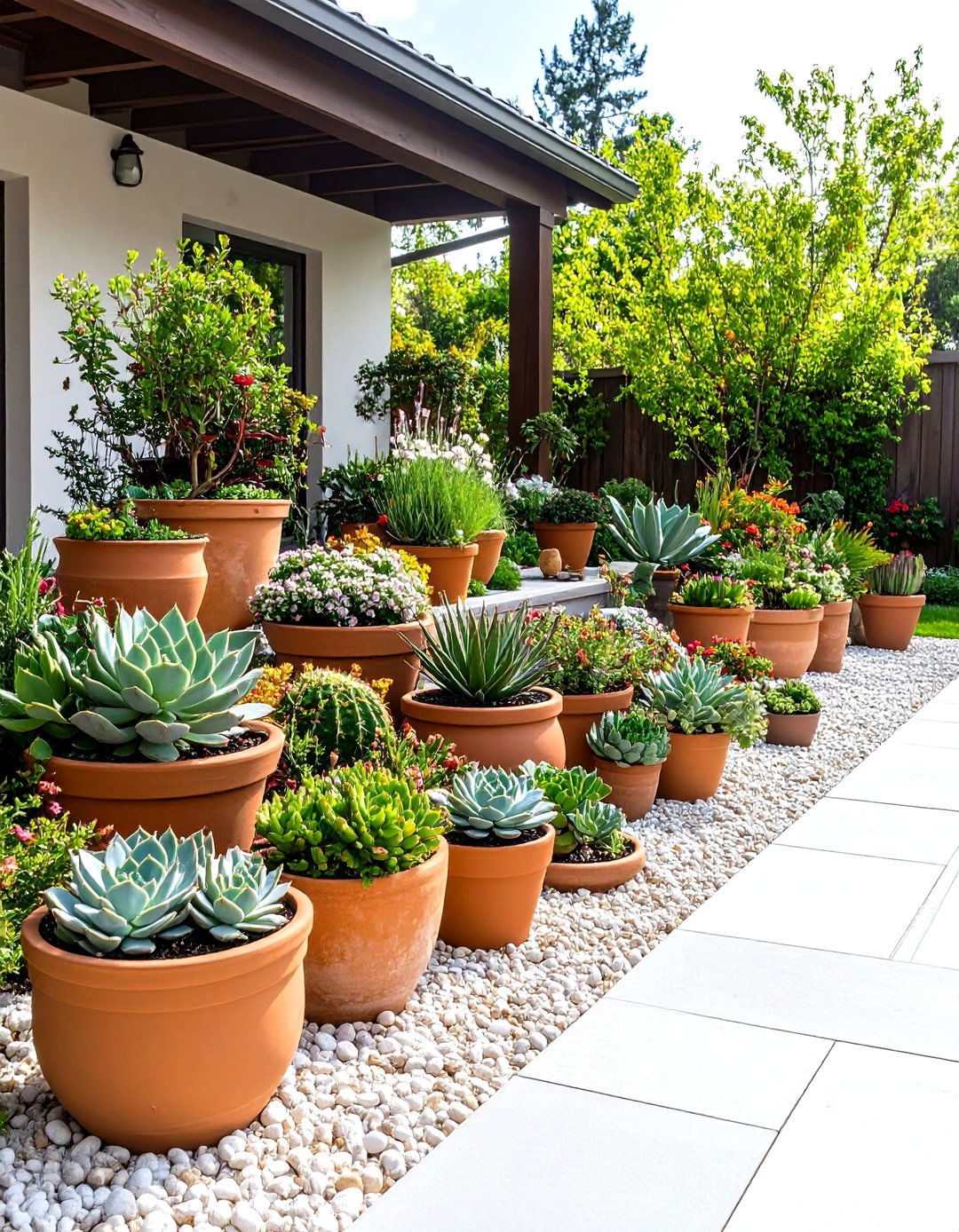
Creating moveable displays with drought-tolerant succulents offers ultimate flexibility in your water-wise landscape design. Arrange various container sizes featuring different succulent varieties like echeveria, sedum, and jade plants to create stunning focal points that require minimal watering. Choose terra cotta or ceramic pots with drainage holes, using specialized cactus potting mix for optimal growth. Group containers with thriller, filler, and spiller combinations—tall agave as the centerpiece, colorful hen-and-chicks as fillers, and trailing string of pearls cascading over edges. Position containers on gravel beds or stone patios to enhance the desert aesthetic while providing excellent drainage. During extreme weather, containers can be easily relocated to protected areas, making this xeriscape solution perfect for renters or those wanting seasonal garden flexibility.
2. Xeriscape Mediterranean Herb Spiral
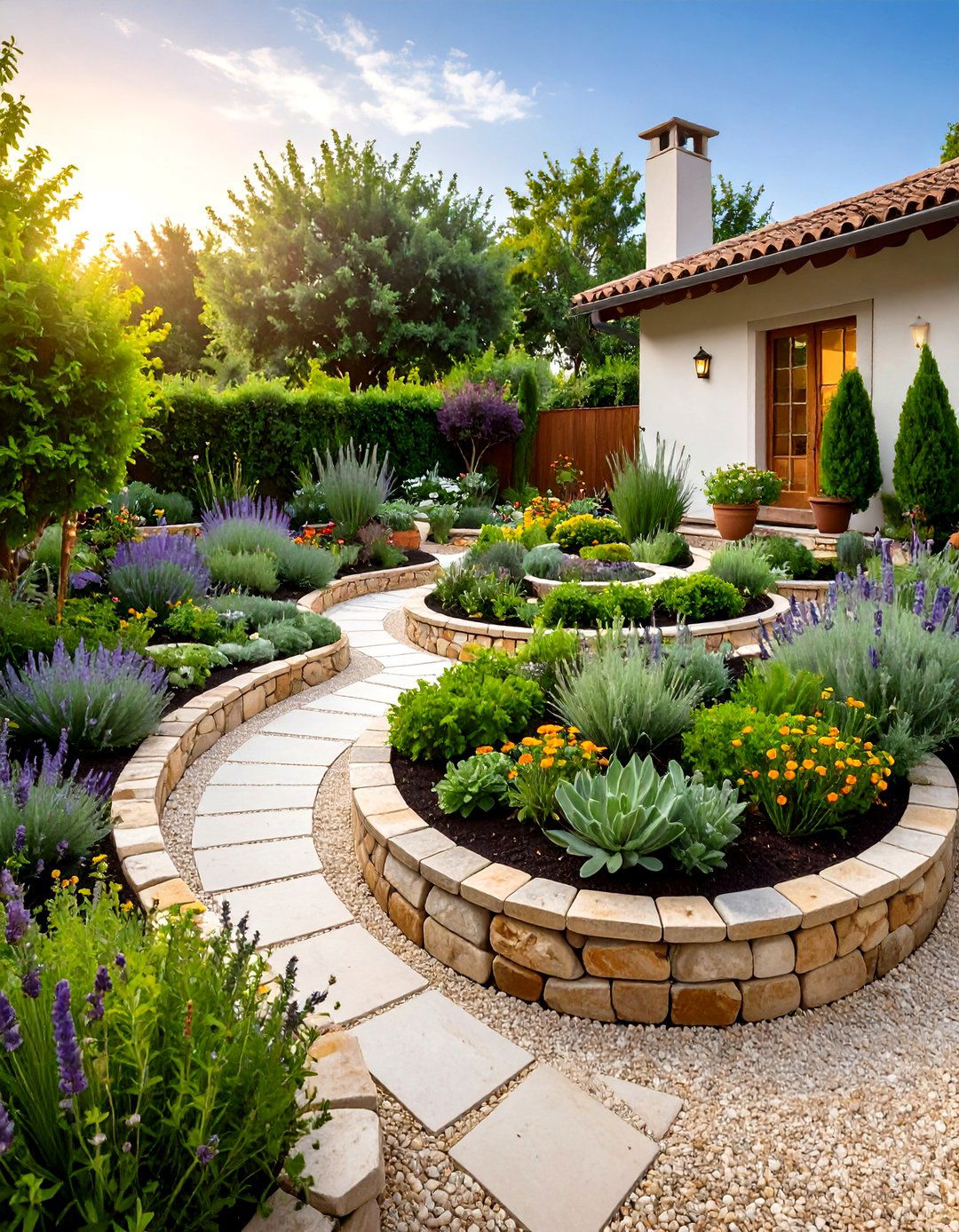
Design an aromatic herb spiral using drought-resistant Mediterranean plants that provide both culinary value and water conservation benefits. Build a spiral-shaped raised bed using natural stones, starting low on one end and gradually increasing height to create microclimates for different herbs. Plant rosemary, lavender, thyme, oregano, and sage throughout the spiral, positioning sun-loving varieties at the top and those preferring slight moisture at the bottom. The spiral design maximizes growing space while creating natural drainage pathways that prevent water accumulation. Mulch pathways between herb sections with gravel or crushed stone to suppress weeds and retain soil moisture. This functional xeriscape feature provides fresh herbs for cooking while attracting beneficial pollinators with fragrant blooms. The varied heights and textures create visual interest while requiring significantly less water than traditional herb gardens.
3. Xeriscape Gravel River Bed

Transform drainage challenges into stunning landscape features by creating a dry riverbed using decorative gravel and strategically placed rocks. Design meandering pathways that mimic natural water flow, using larger boulders to simulate riverbanks and smaller pea gravel for the flowing center. Plant drought-tolerant ornamental grasses and native wildflowers along the edges to soften harsh lines while providing erosion control. During rare rainfall events, this xeriscape feature functions as a natural drainage system, directing water flow away from structures while preventing soil erosion. Choose river rocks in complementary colors—warm browns and grays for natural appeal, or lighter tones for contemporary aesthetics. Incorporate stepping stones across the riverbed to create functional pathways while maintaining the illusion of flowing water. This low-maintenance design eliminates the need for irrigation while adding dynamic visual movement to flat landscapes.
4. Xeriscape Native Plant Prairie
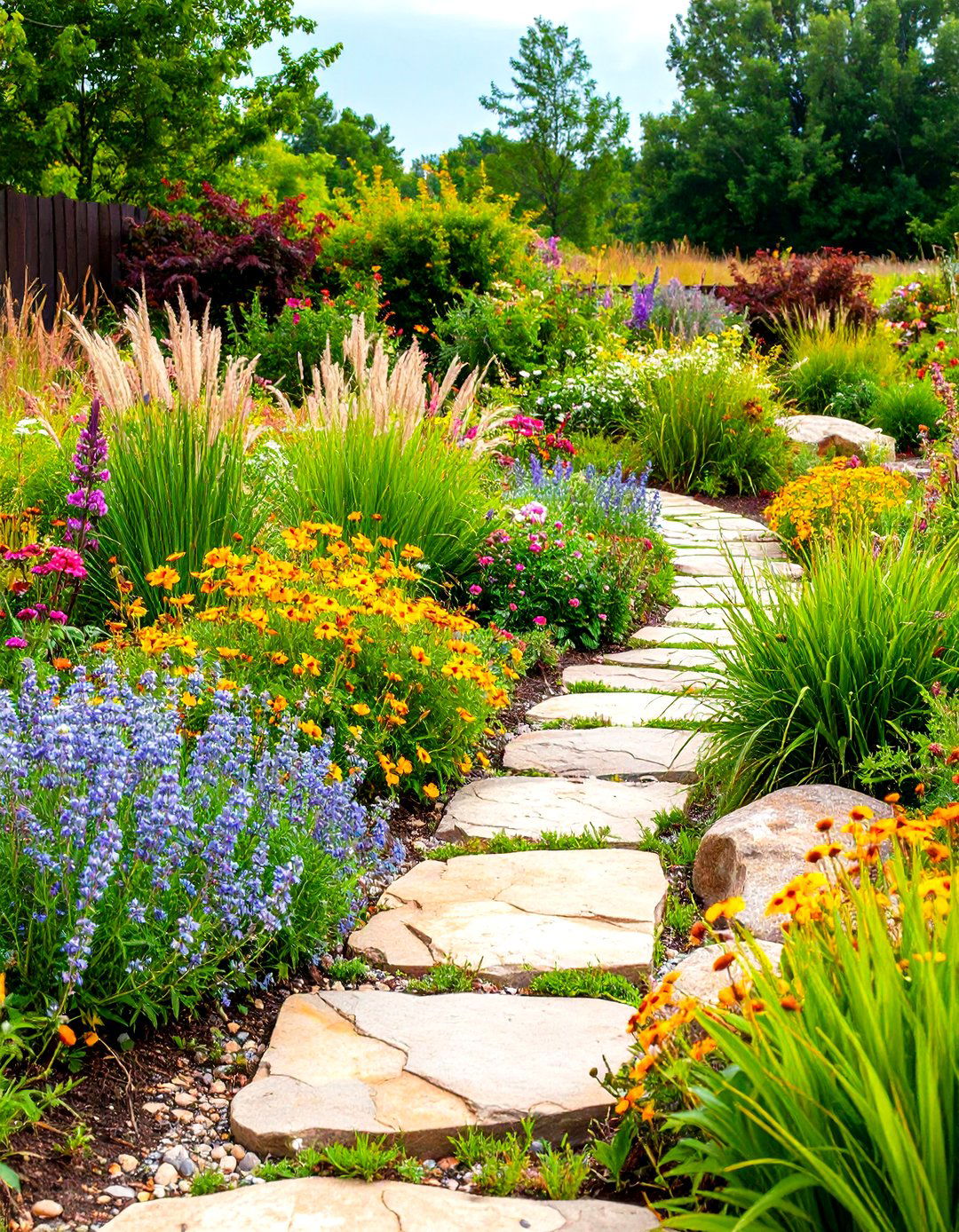
Establish a thriving ecosystem using indigenous plants adapted to your local climate conditions, creating a self-sustaining landscape that requires no supplemental watering. Research native wildflowers, grasses, and shrubs that historically grew in your region, focusing on species that provide food and habitat for local wildlife. Plant in natural groupings rather than formal rows, allowing plants to spread and naturalize over time. Include early, mid, and late-season bloomers to ensure continuous color throughout the growing season. Native plant prairies become more beautiful and resilient each year as deep root systems develop, naturally suppressing weeds and preventing soil erosion. Add rustic pathways using local materials like flagstone or wood chips to create access for maintenance and wildlife observation. This xeriscape approach supports biodiversity while dramatically reducing water consumption, fertilizer needs, and maintenance requirements compared to traditional landscaping.
5. Xeriscape Rock Garden Crevice
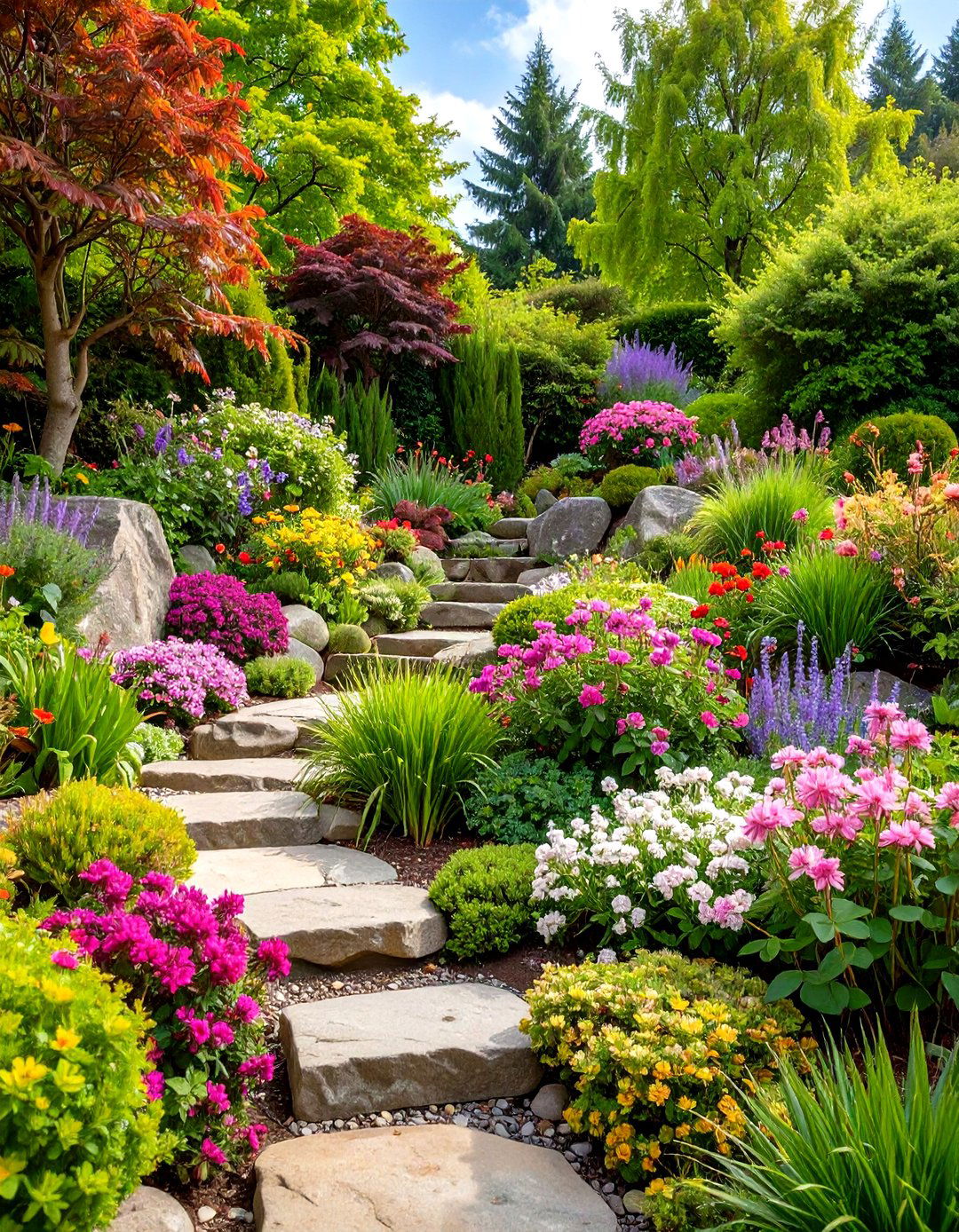
Create dramatic vertical gardens by planting drought-tolerant species between natural rock formations and stone walls. Select plants with shallow root systems that thrive in rocky conditions, such as sedums, sempervivums, and native alpine species. Position rocks to create natural pockets and crevices where soil can accumulate, providing growing spaces for small plants while ensuring excellent drainage. Use a mixture of boulder sizes to create visual interest and varied planting opportunities—large anchor stones for structure and smaller rocks for detailed planting areas. Fill crevices with well-draining soil mixtures containing sand and gravel to prevent water retention that could damage plant roots. This xeriscape technique maximizes planting space in challenging terrain while creating stunning three-dimensional gardens. The rock thermal mass moderates soil temperature extremes, protecting plants during hot days and cold nights while requiring virtually no irrigation once established.
6. Xeriscape Permeable Hardscape Patio

Design functional outdoor living spaces using permeable materials that allow rainwater infiltration while eliminating irrigation needs. Install permeable pavers, decomposed granite, or gravel surfaces that provide stable footing for furniture while preventing water runoff. Create defined seating areas using large flagstones or natural boulders as benches, surrounding them with drought-tolerant plants for privacy and aesthetic appeal. Incorporate built-in planters using the same materials as paving to maintain design continuity while showcasing specimen plants like architectural agaves or flowering desert trees. Edge hardscape areas with drought-resistant ground covers that soften transitions between paved and planted spaces. This xeriscape approach eliminates lawn irrigation needs while creating functional spaces for entertaining and relaxation. Permeable surfaces help recharge groundwater supplies while reducing stormwater runoff, contributing to environmental sustainability while providing low-maintenance outdoor enjoyment areas that require no ongoing water input.
7. Xeriscape Ornamental Grass Meadow
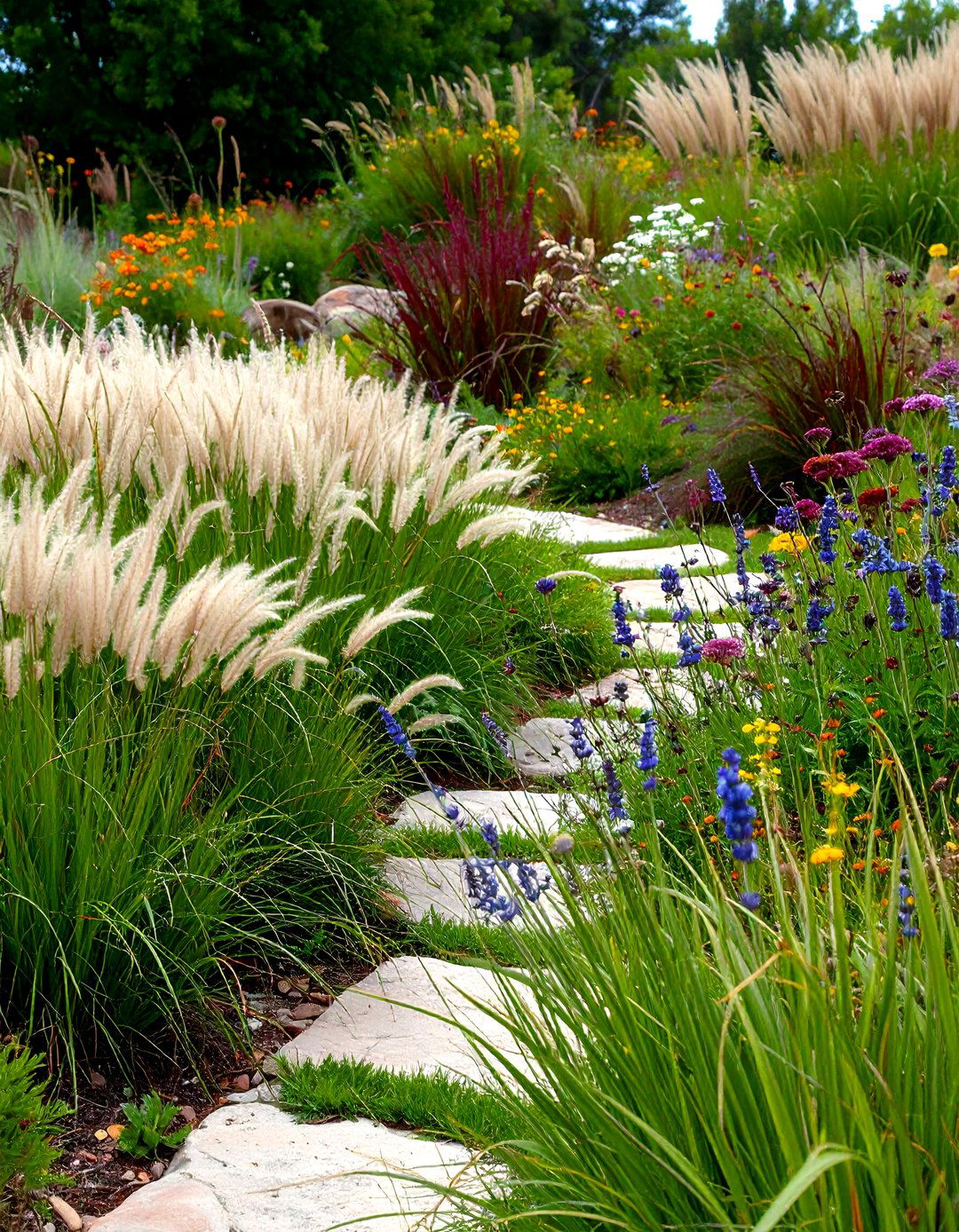
Establish flowing meadow-like landscapes using drought-tolerant ornamental grasses that provide year-round structure and seasonal interest. Select native and adapted grass species with different heights, textures, and bloom times to create dynamic compositions that change throughout the seasons. Plant varieties like blue grama, buffalo grass, and fountain grass in natural drifts rather than formal arrangements, allowing them to sway together in breezes for movement and sound. Incorporate scattered drought-tolerant wildflowers among grasses for seasonal color bursts without requiring additional water. The deep root systems of established ornamental grasses prevent soil erosion while requiring no irrigation after the first growing season. Add subtle pathways mowed through taller grasses to create access and visual interest. This xeriscape design provides habitat for beneficial insects and birds while offering a naturalistic alternative to water-hungry lawn areas that captures the beauty of natural grasslands.
8. Xeriscape Sculptural Focal Point Garden
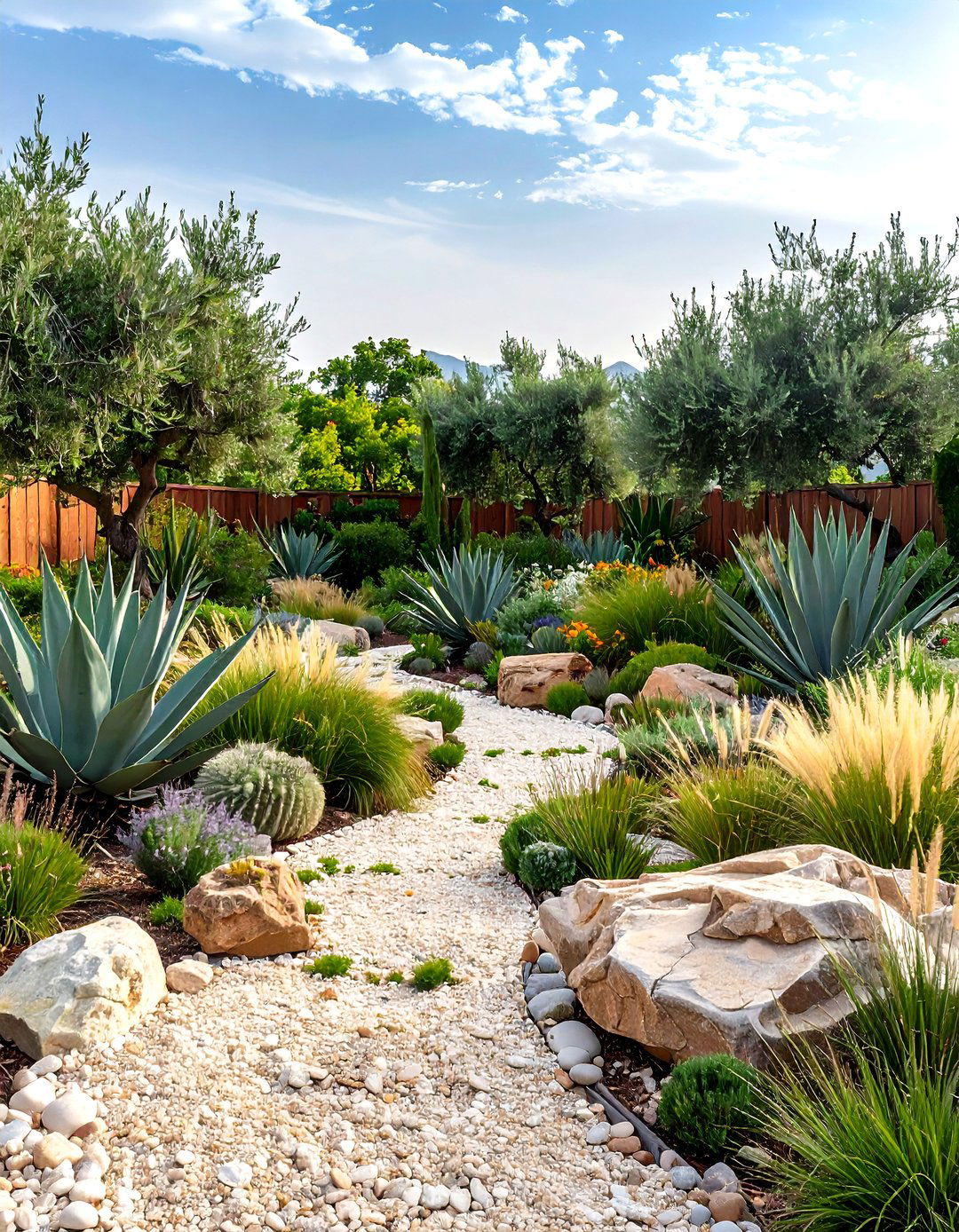
Create stunning centerpiece gardens featuring architectural plants and artistic elements that command attention while conserving water. Select bold specimen plants like yucca, agave, or mature olive trees as living sculptures, positioning them strategically to draw the eye and anchor landscape designs. Surround focal plants with complementary drought-tolerant species in contrasting textures—soft ornamental grasses against spiky succulents, or fine-textured groundcovers beneath bold architectural forms. Incorporate non-plant focal elements like large boulders, modern planters, or artistic sculptures to enhance visual impact while requiring zero water input. Use mulches like decorative gravel or colored stone to define planting areas and suppress weeds while contributing to the overall aesthetic design. This xeriscape approach creates memorable landscapes that serve as outdoor art installations while demonstrating that water conservation doesn't mean sacrificing visual drama or design sophistication.
9. Xeriscape Edible Desert Garden

Combine food production with water conservation by growing drought-tolerant edible plants that thrive in arid conditions. Plant Mediterranean vegetables like artichokes, fennel, and cardoon alongside drought-resistant herbs such as rosemary, oregano, and sage for a productive landscape requiring minimal irrigation. Include edible cacti like prickly pear for unique culinary opportunities while adding dramatic structural elements to garden designs. Design raised beds using local stone or recycled materials to improve drainage and soil warmth for heat-loving crops. Incorporate dwarf fruit trees adapted to dry conditions, such as pomegranates, figs, or olive trees, which provide food while serving as attractive landscape anchors. Mulch heavily with organic materials to retain soil moisture and suppress weeds around edible plants. This xeriscape approach proves that food gardens can be both productive and water-wise, providing fresh ingredients while reducing grocery bills and environmental impact through reduced irrigation needs.
10. Xeriscape Pollinator Haven
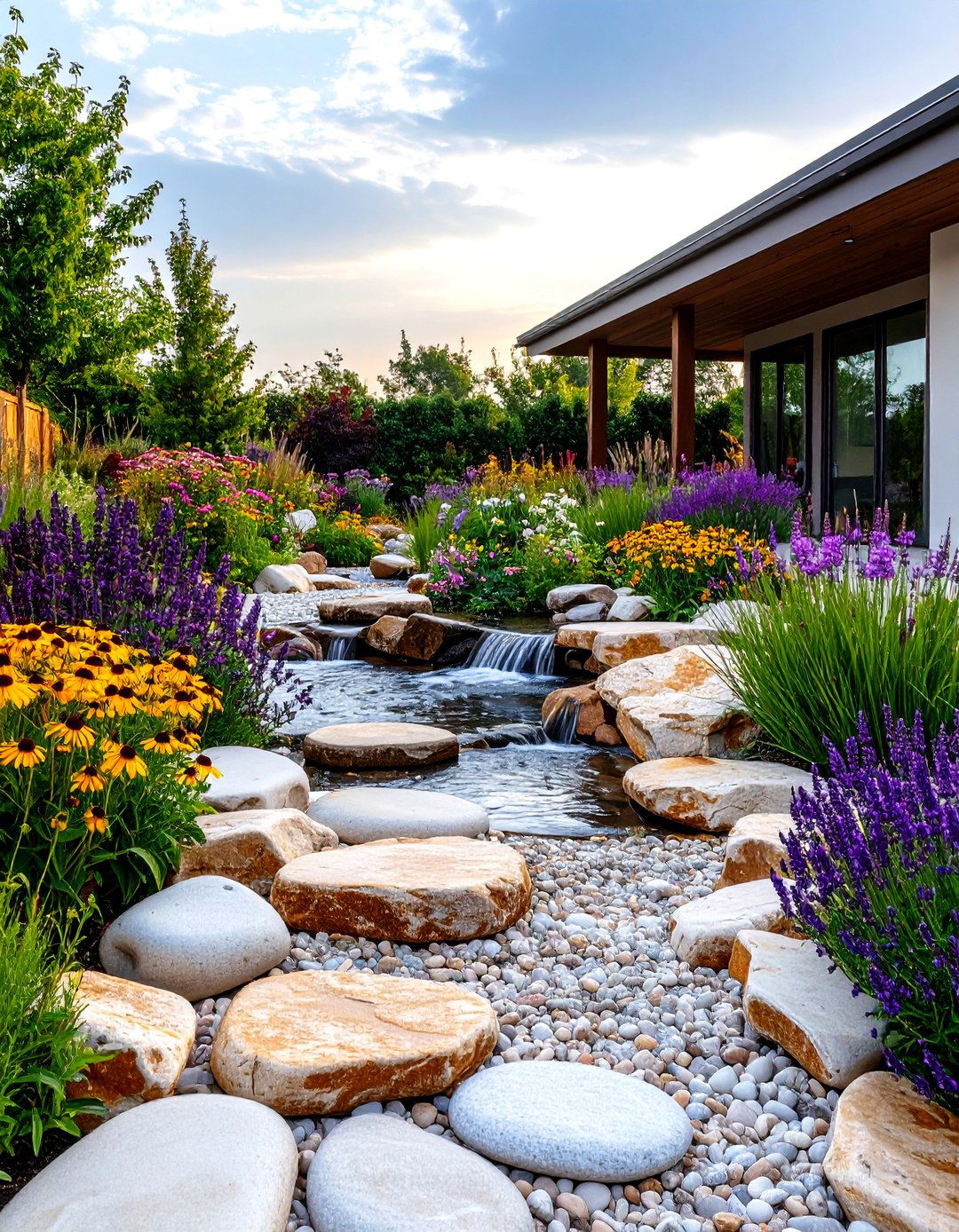
Design specialized gardens that support beneficial insects while requiring minimal water through strategic plant selection and habitat creation. Choose native flowering plants with extended bloom periods that provide nectar and pollen throughout growing seasons—plants like purple coneflower, black-eyed Susan, and native salvias attract butterflies, bees, and other pollinators. Create diverse microhabitats by varying plant heights and textures, providing nesting sites for beneficial insects while ensuring continuous food sources. Include host plants for butterfly larvae alongside nectar sources for adult insects, creating complete habitat systems within water-wise landscapes. Add shallow water features like saucers filled with pebbles and water for pollinator drinking stations without creating mosquito breeding areas. Plant in clusters rather than single specimens to maximize visual impact and foraging efficiency for visiting insects. This xeriscape design supports local ecosystems while reducing environmental impact through decreased water usage and eliminated pesticide needs for maintaining pollinator-friendly environments.
11. Xeriscape Seasonal Color Rotation
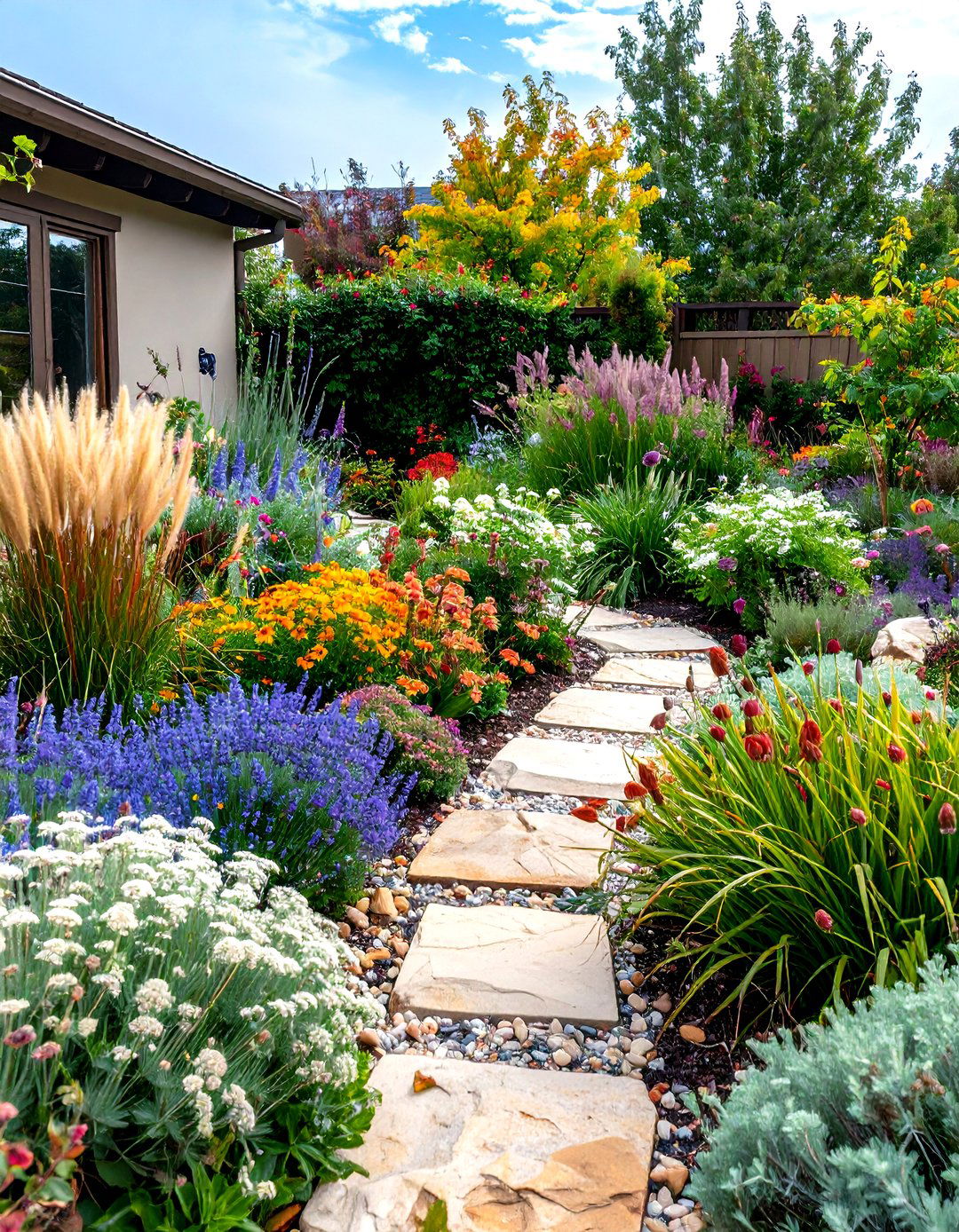
Develop dynamic landscapes that provide year-round interest through strategic plantings of drought-tolerant species with varying seasonal highlights. Plan plant combinations that ensure something is always blooming or providing colorful foliage throughout different seasons—spring bulbs like alliums, summer bloomers like yarrow, fall-colored grasses, and winter-interesting bark or seed heads. Include evergreen drought-tolerant plants as backbone structures that provide consistency while seasonal plants add changing elements. Use drought-resistant annuals sparingly as accent plants in containers or small beds where they can be easily replaced without disturbing established plantings. Select plants with attractive seed heads or winter silhouettes that provide interest during dormant seasons without requiring removal or replacement. This xeriscape approach maintains visual appeal throughout the year while minimizing water usage and maintenance requirements compared to traditional gardens that rely heavily on water-dependent flowering plants for seasonal color displays.
12. Xeriscape Ground Cover Replacement
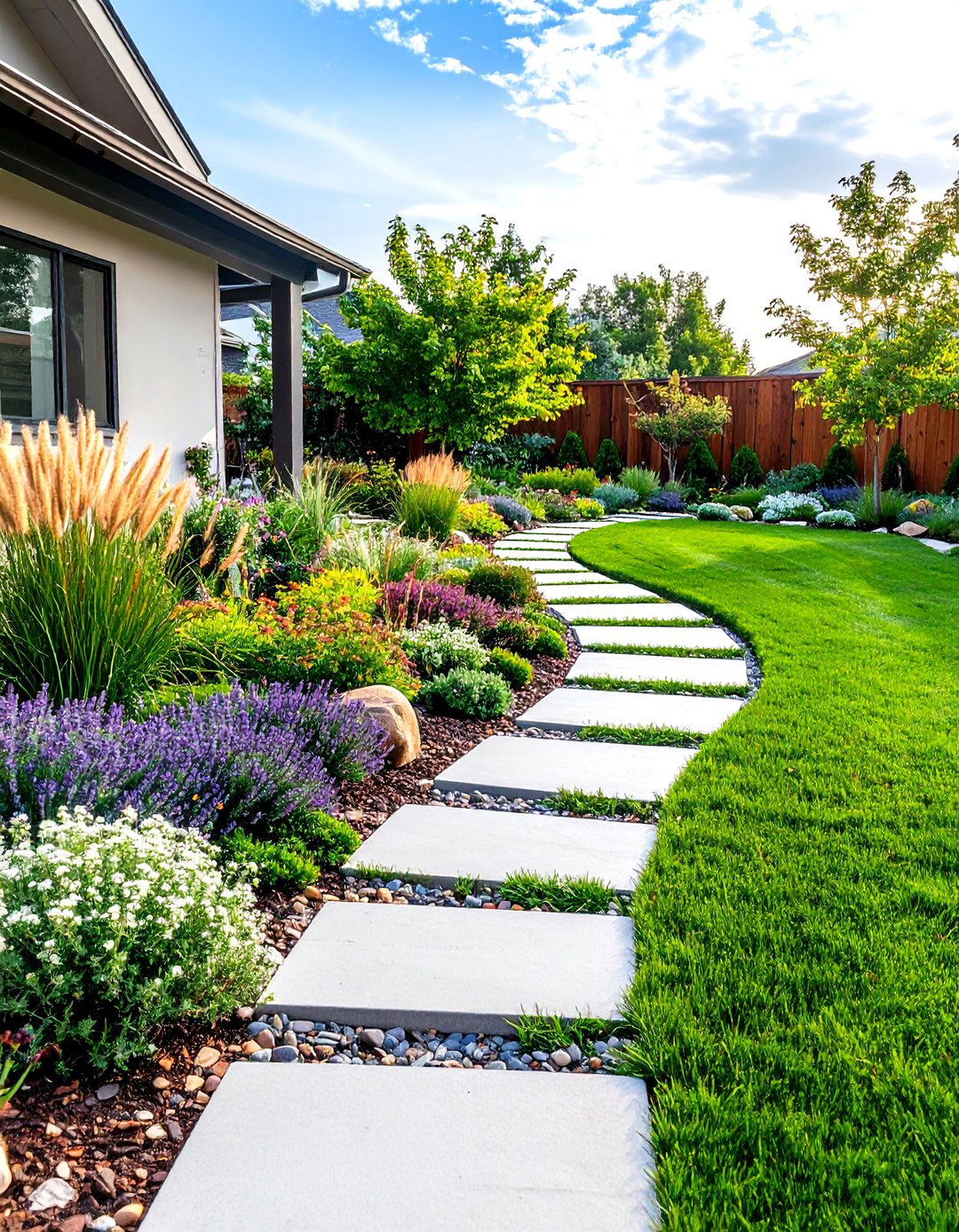
Transform water-hungry lawn areas into beautiful, low-maintenance ground cover carpets using drought-tolerant spreading plants. Select vigorous ground covers like creeping thyme, sedum varieties, or native bunch grasses that form dense mats suppressing weeds while requiring no irrigation once established. Plant ground covers in naturalistic patterns rather than formal borders, allowing them to flow together and create living mulch that conserves soil moisture. Include pathways using stepping stones or informal gravel paths to provide access while maintaining ground cover integrity. Choose species with different textures and seasonal interests—some with flowers, others with colorful foliage, and varieties that remain attractive during dormant periods. This xeriscape solution eliminates mowing, fertilizing, and irrigation requirements while providing erosion control and habitat value. Ground cover areas become more attractive each year as plants mature and spread, eventually creating self-sustaining carpets that require only occasional maintenance to remove weeds or divide overgrown sections.
13. Xeriscape Vertical Wall Garden
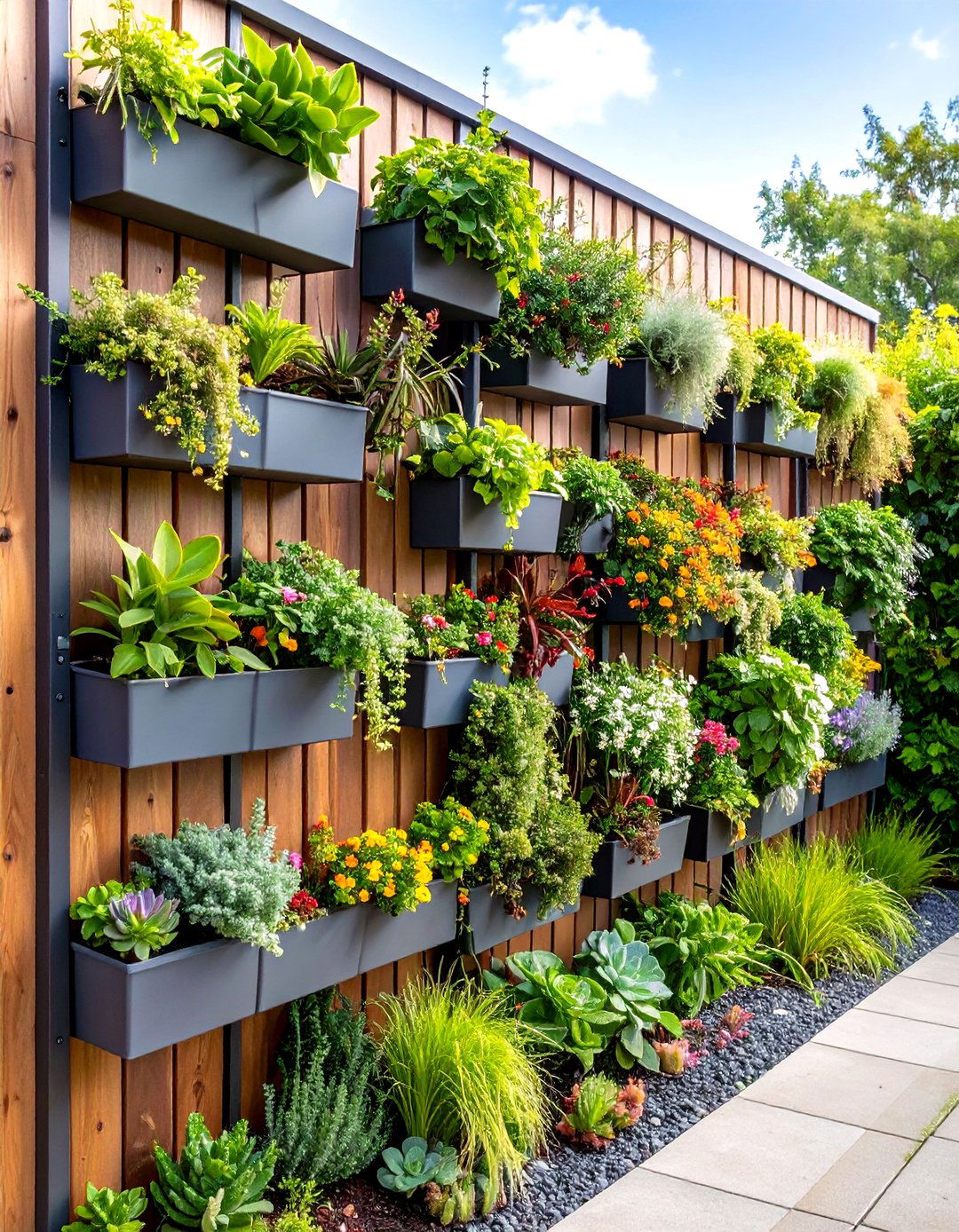
Maximize planting space while conserving water by creating vertical gardens using drought-tolerant plants on walls, fences, or specially constructed structures. Install pocket planters, wall-mounted containers, or build vertical structures using natural materials like stone or wood for mounting drought-resistant plants. Select plants with shallow root systems and low water requirements such as sedums, air plants, or small succulents that thrive in confined spaces. Design irrigation systems using drip emitters or soaker hoses that deliver water efficiently to individual plant pockets without waste. Include trailing species that cascade downward to create living curtains of greenery requiring minimal water input. Position vertical gardens to receive appropriate light levels for selected plants while protecting them from extreme weather conditions. This xeriscape technique transforms unused vertical spaces into productive growing areas while reducing ground-level water requirements and creating dramatic design statements that demonstrate creative water-wise gardening possibilities in limited spaces.
14. Xeriscape Rain Capture Integration
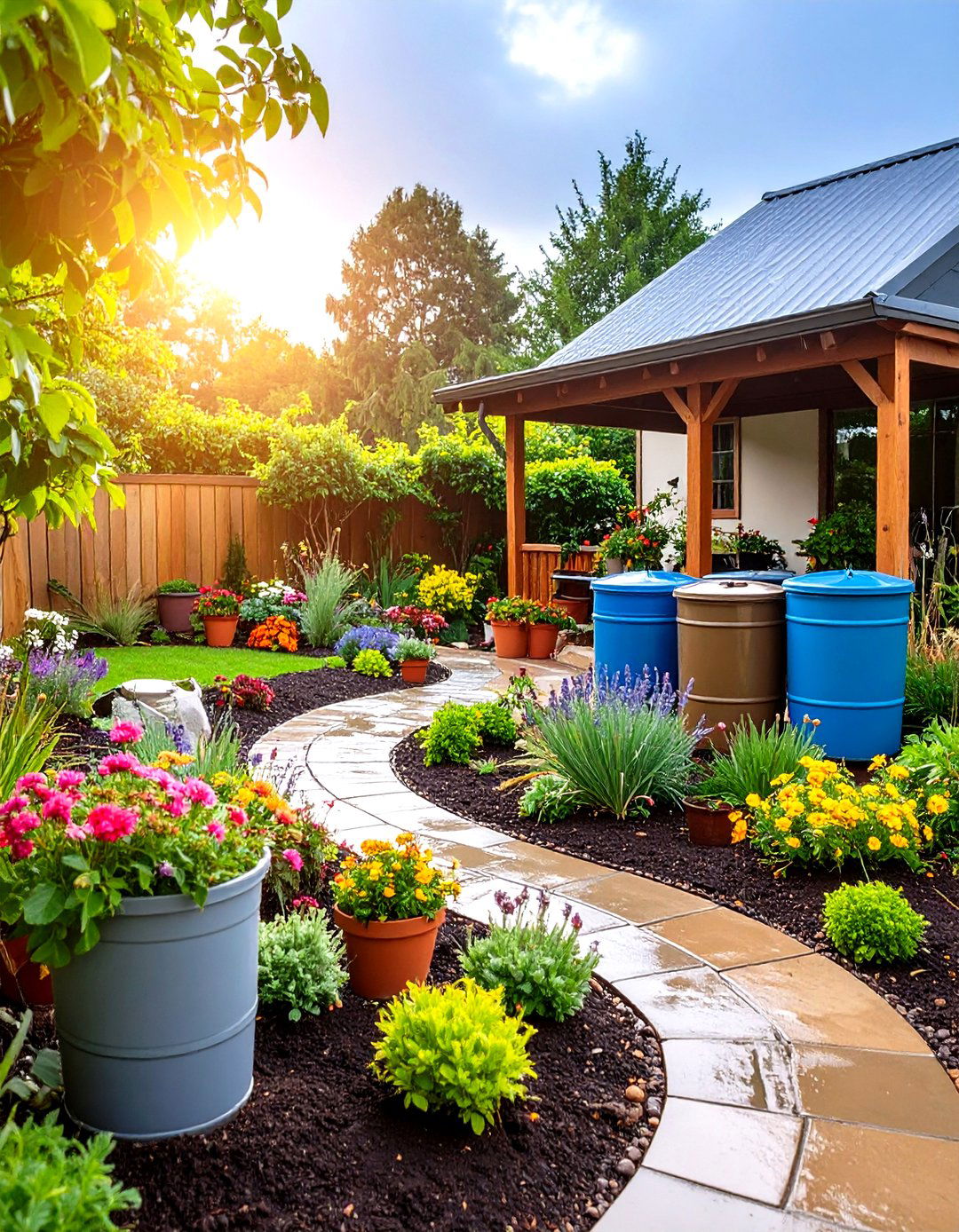
Design landscapes that capture and utilize natural rainfall efficiently, reducing or eliminating the need for supplemental irrigation systems. Install rain gardens in natural low spots or create berms and swales that direct water flow toward drought-tolerant plantings. Position rain barrels or cisterns strategically to collect roof runoff for occasional deep watering during extended dry periods. Select plants that benefit from periodic deep soaking rather than frequent shallow watering, such as native trees and shrubs with extensive root systems. Create permeable surfaces that allow rainwater infiltration rather than runoff, using gravel paths, permeable pavers, or organic mulches that absorb and slowly release moisture. Design microclimates by positioning water-sensitive plants in areas that naturally receive more moisture while placing extremely drought-tolerant species in drier zones. This xeriscape approach works with natural water cycles rather than against them, creating self-sustaining landscapes that become more resilient and beautiful as they mature and establish deeper root systems.
15. Xeriscape Zen Minimalist Garden
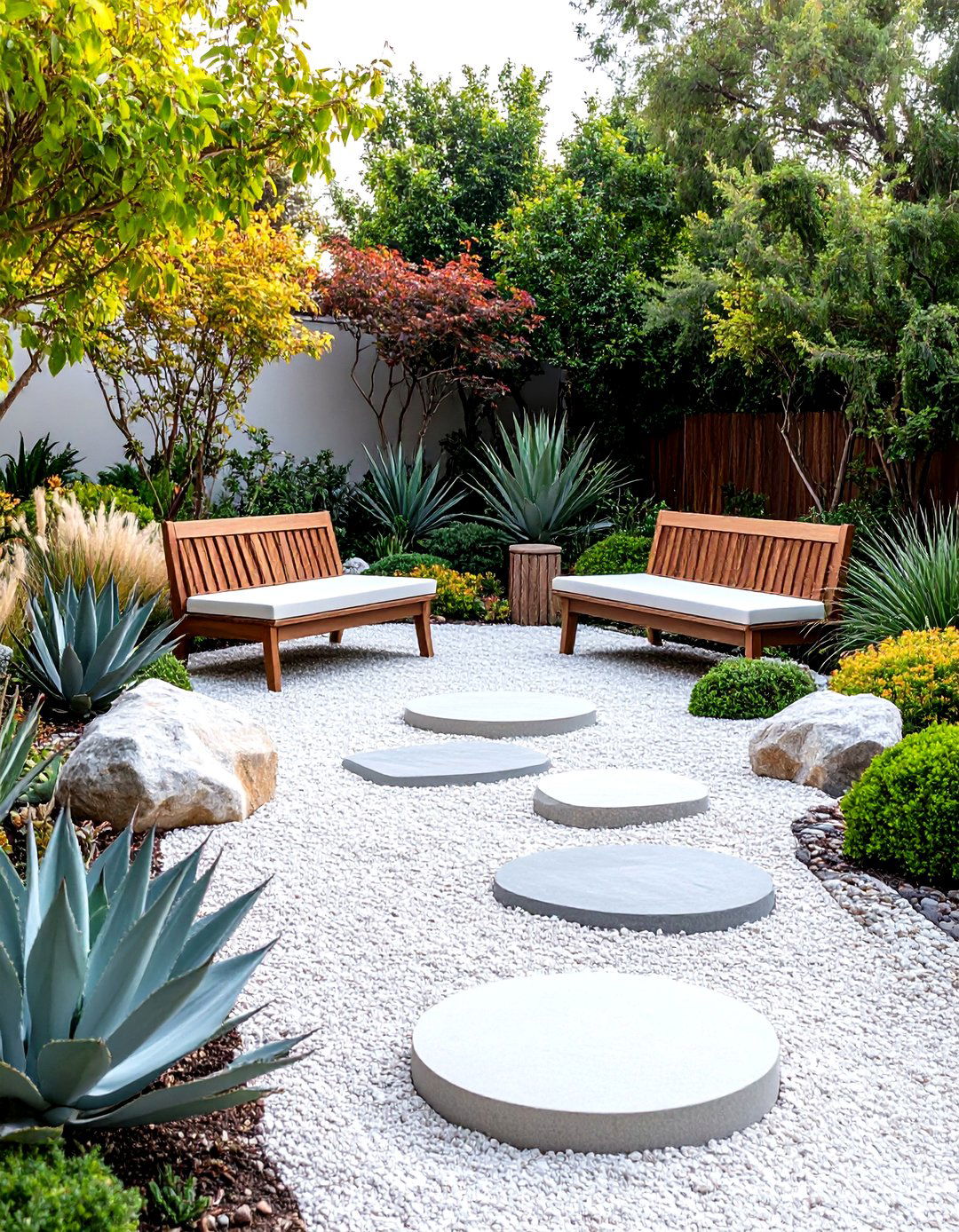
Create tranquil, contemplative spaces using simple design principles and carefully selected drought-tolerant plants that require minimal maintenance. Design clean lines using geometric plantings, raked gravel areas, and strategically placed rocks or architectural plants as focal points. Select plants with strong structural forms like ornamental grasses, agaves, or pruned shrubs that maintain their shape without frequent intervention. Use monochromatic or limited color palettes focusing on texture and form rather than floral displays—gray-leafed plants, various green tones, and seasonal interest from seed heads or bark. Incorporate meditation areas using simple stone benches or platforms surrounded by aromatic plants like lavender or sage. Create pathways using flat stepping stones over raked gravel or decomposed granite surfaces that require no watering. This xeriscape style emphasizes tranquility and mindfulness while demonstrating that sophisticated design requires neither complex maintenance nor high water usage to achieve peaceful, beautiful outdoor sanctuaries.
16. Xeriscape Wildlife Habitat Corridor
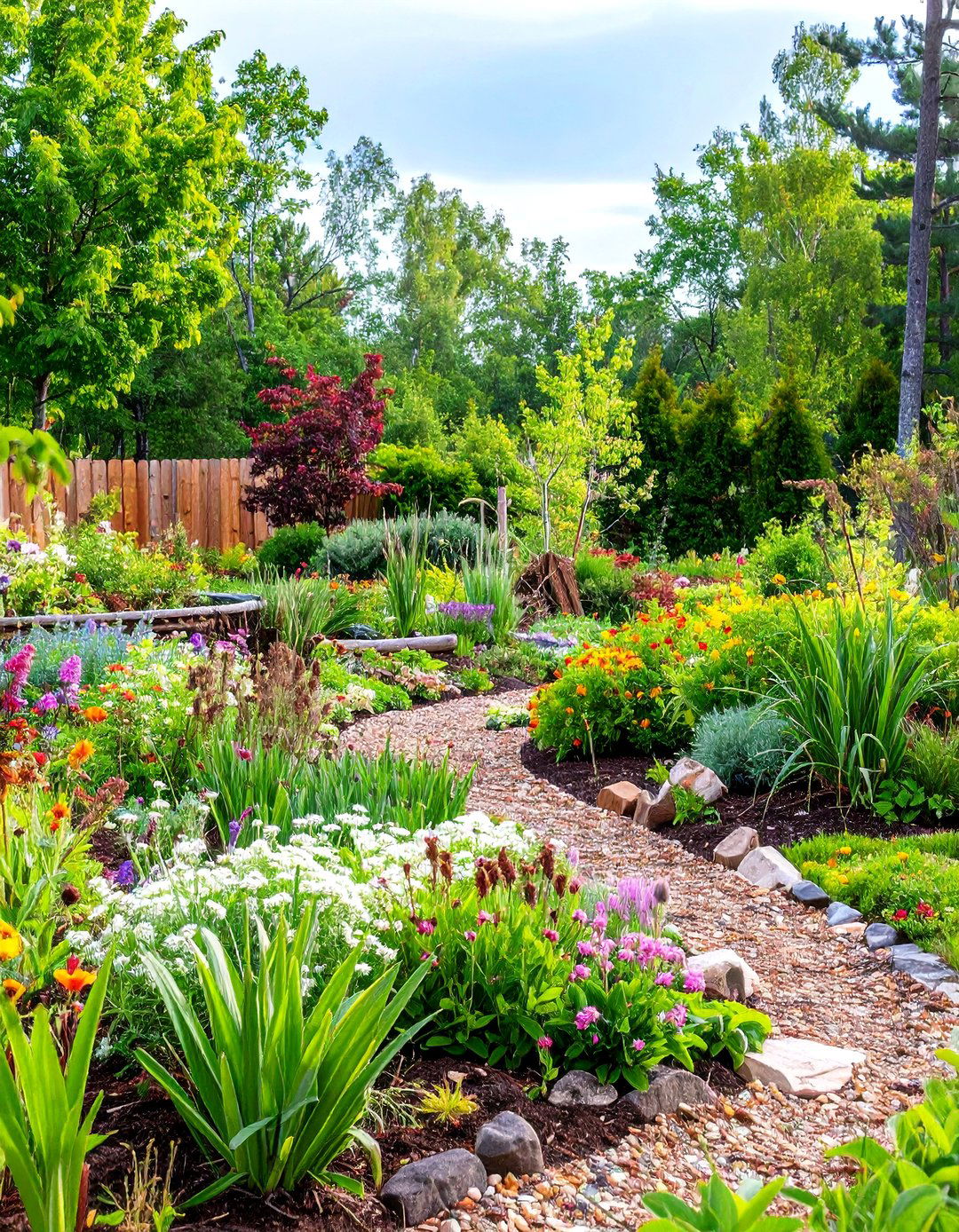
Establish interconnected plant communities that provide food, shelter, and nesting sites for local wildlife using drought-tolerant native species. Layer plantings to create diverse habitat structures—canopy trees, understory shrubs, herbaceous perennials, and ground covers that support different wildlife species throughout the year. Include berry-producing plants, seed-producing flowers, and plants that host beneficial insects to provide complete ecosystem services. Create water sources using shallow basins, bird baths, or seasonal wetland areas that collect rainwater without requiring constant refilling. Leave some areas "messy" with brush piles, log structures, or unmowed sections that provide overwintering sites for beneficial insects and small animals. Connect habitat areas using corridors of native plants that allow wildlife movement between different garden zones. This xeriscape approach creates functional ecosystems that support biodiversity while requiring minimal water input once established, demonstrating how conservation and wildlife support can coexist beautifully in residential landscapes.
17. Xeriscape Architectural Border Design
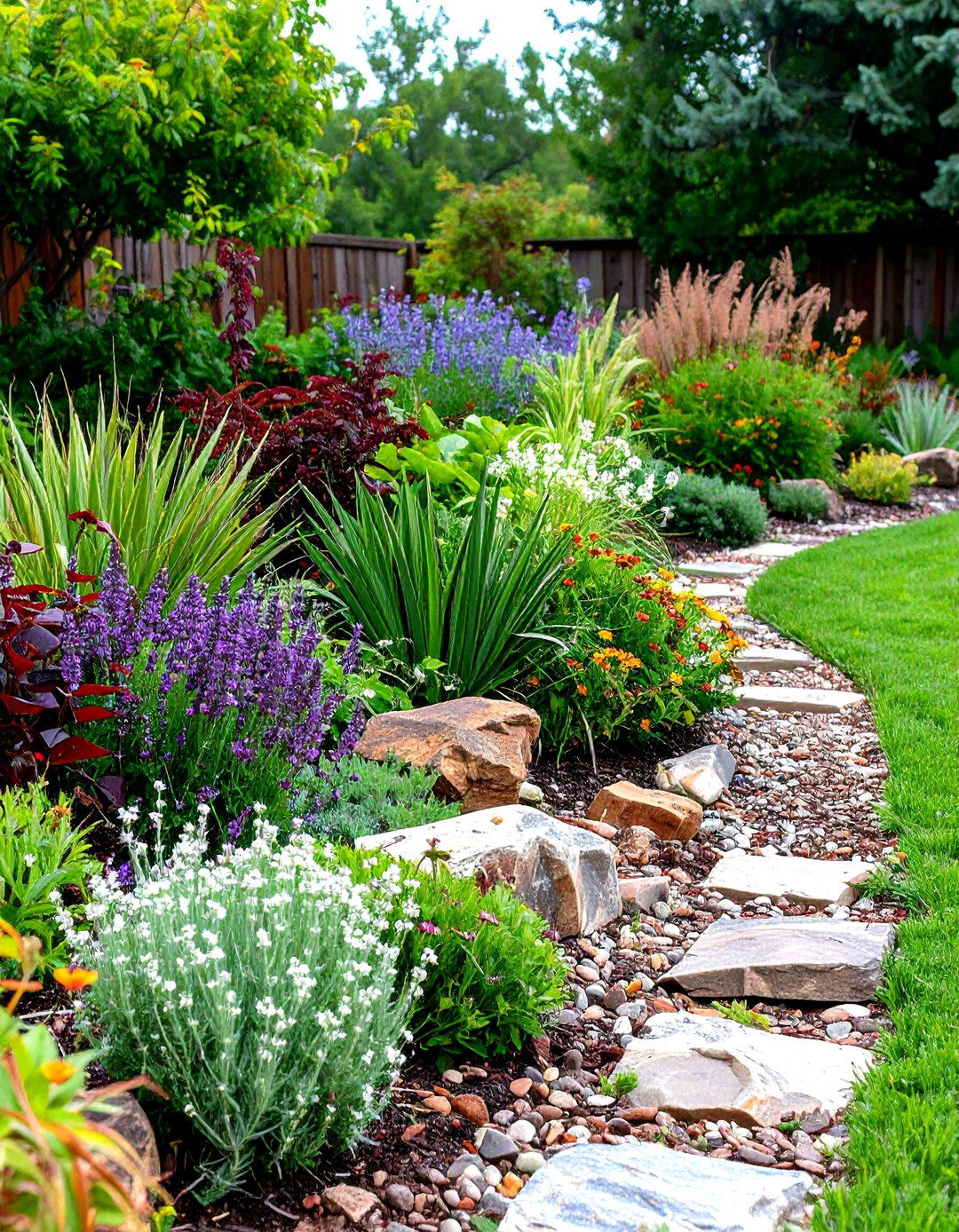
Frame property boundaries and create definition using drought-tolerant plants arranged in sophisticated border designs that require minimal irrigation. Design layered plantings with varying heights and textures—tall backdrop plants, medium shrubs, and low foreground species that create depth and visual interest throughout seasons. Select plants with strong architectural qualities like yucca, ornamental grasses, or flowering perennials that maintain structure even when dormant. Use repetition of key plant species along borders to create unity while varying companion plants to prevent monotony. Include seasonal interest through plants with attractive bark, persistent seed heads, or evergreen foliage that provide year-round structure. Edge borders with drought-tolerant ground covers or decorative mulches that define planting areas while suppressing weeds. This xeriscape technique creates polished, professional-looking landscapes that enhance property value while demonstrating that water conservation and design sophistication are completely compatible approaches to modern landscaping.
18. Xeriscape Therapeutic Sensory Garden
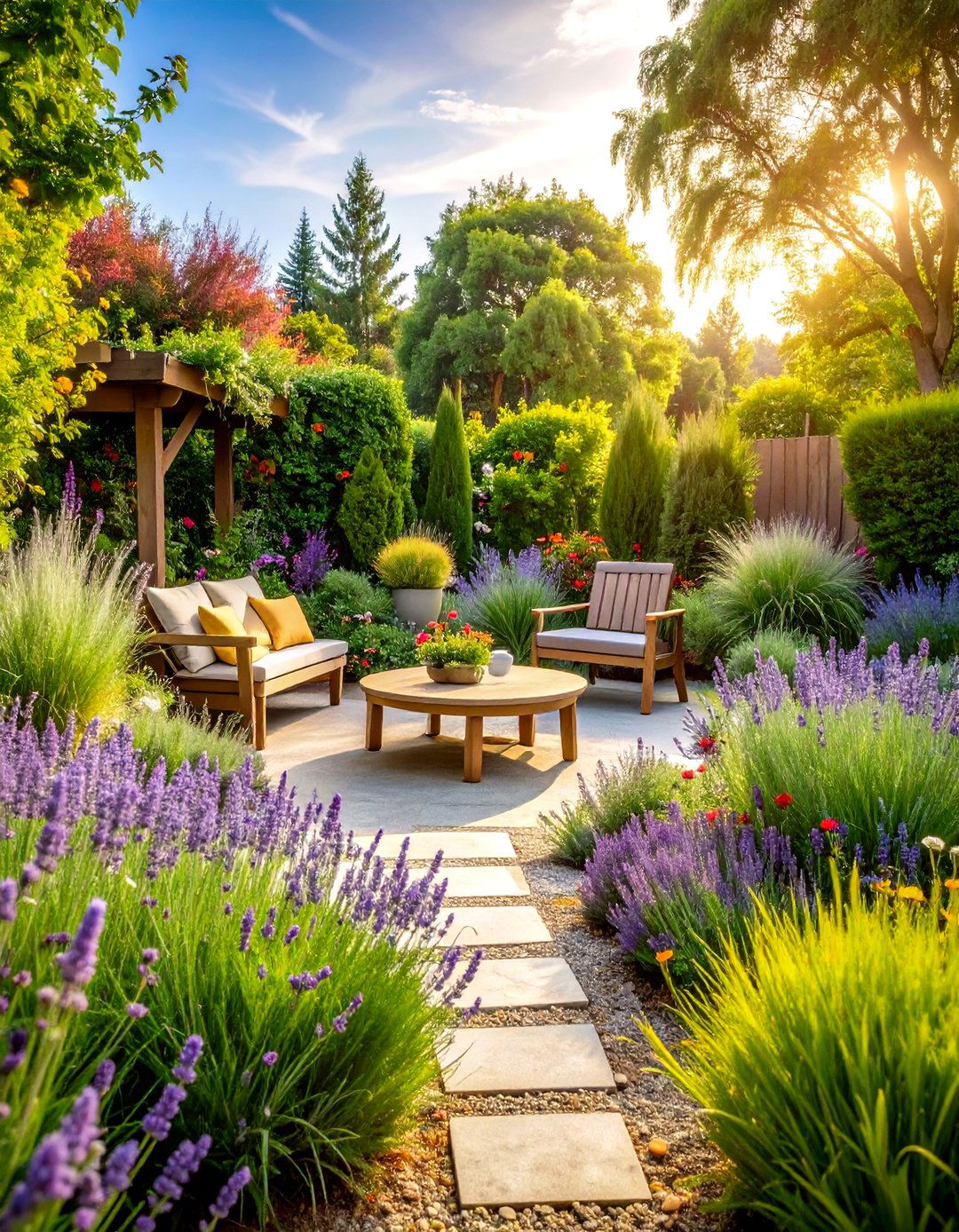
Design healing gardens that engage all five senses using aromatic, textural, and visually interesting drought-tolerant plants. Include fragrant plants like lavender, rosemary, and native sages that release scent when touched or brushed against, creating calming aromatherapy experiences. Plant species with interesting textures—soft lamb's ear, spiky ornamental grasses, and smooth succulent leaves that invite tactile exploration. Select plants that attract birds and beneficial insects, providing natural sounds and movement that enhance peaceful garden experiences. Include edible plants like herbs and drought-tolerant fruits that engage taste while providing practical benefits. Position seating areas surrounded by sensory plants where visitors can comfortably interact with garden elements. Use materials like smooth river rocks, textured bark mulch, and fragrant wood elements that contribute to sensory experiences. This xeriscape approach creates therapeutic environments that support mental and physical well-being while requiring minimal water input, proving that healing gardens can be both sustainable and restorative.
19. Xeriscape Children's Discovery Garden

Create engaging outdoor learning environments using safe, interactive drought-tolerant plants that encourage exploration and education. Include plants with interesting features—fuzzy leaves, unusual forms, colorful flowers, or edible parts that spark curiosity and provide hands-on learning opportunities. Design discovery trails using durable materials like log rounds or stone stepping stones that lead to different garden zones showcasing various plant types and growing conditions. Plant species that change dramatically through seasons, providing ongoing educational opportunities about plant life cycles and adaptation strategies. Include interactive elements like identification signs, measurement markers, or collection areas for seeds and leaves. Create small-scale habitat areas where children can observe insects, birds, and other wildlife attracted to drought-tolerant plants. Use raised beds or container gardens at child-friendly heights for hands-on gardening experiences. This xeriscape design combines environmental education with water conservation, teaching children valuable lessons about sustainability while providing outdoor play and learning opportunities that require minimal maintenance.
20. Xeriscape Four-Season Interest Garden
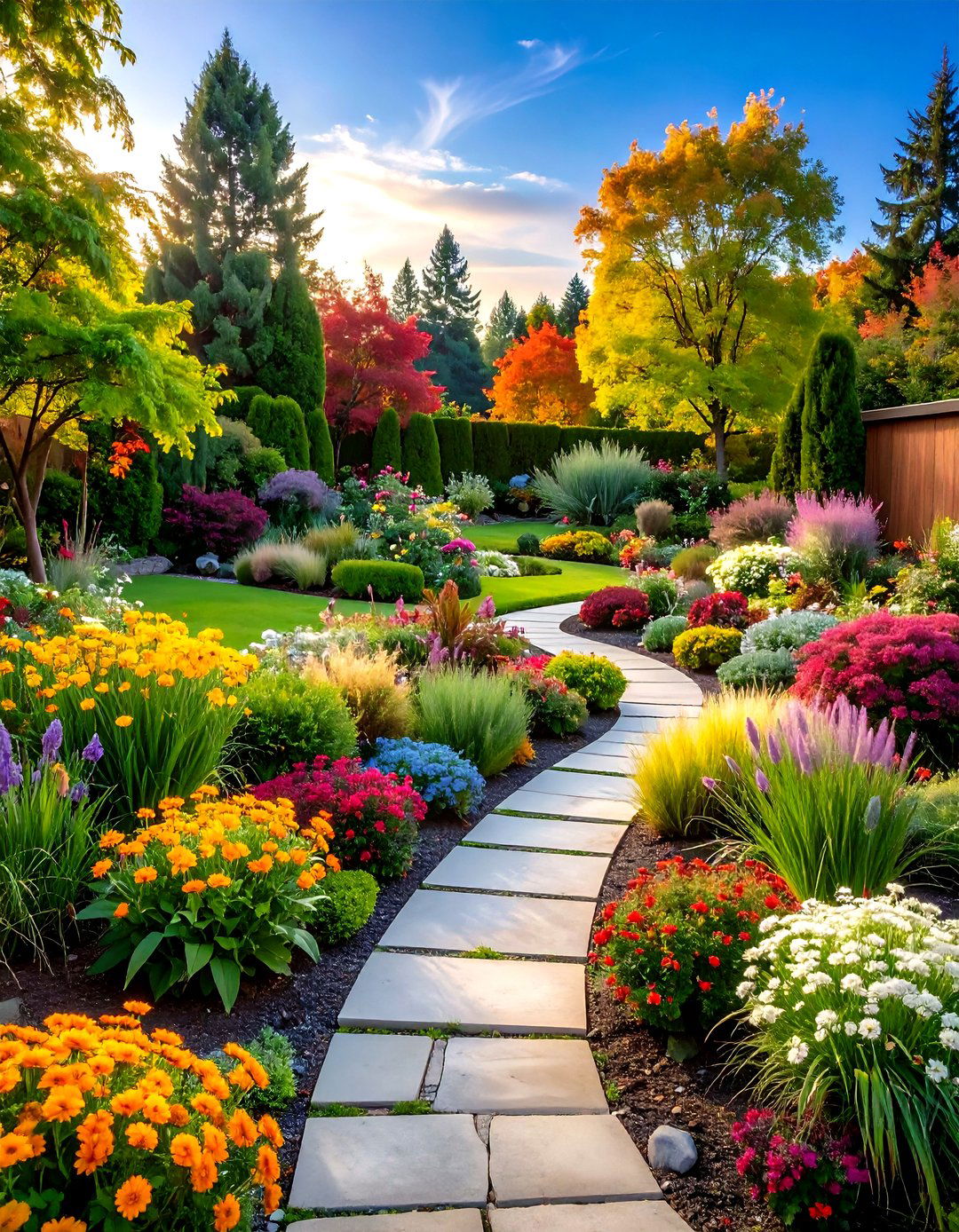
Design comprehensive landscapes that provide visual appeal throughout all seasons using drought-tolerant plants selected for their year-round contributions. Plan plantings that include spring flowering bulbs, summer blooming perennials, fall foliage colors, and winter structural elements like attractive bark, persistent seed heads, or evergreen forms. Layer different plant types to ensure something is always providing interest—early spring bulbs emerging through mulch, summer flower displays, autumn grass plumes, and winter silhouettes against snow or clear skies. Include deciduous and evergreen elements that provide changing and constant features respectively, creating dynamic landscapes that evolve naturally through seasonal cycles. Select plants with multiple seasons of interest—species that bloom, produce colorful foliage, and have attractive winter forms. Use hardscape elements like stone features or artistic sculptures that remain visible and attractive throughout all seasons. This xeriscape approach demonstrates that water-wise gardens can be more interesting and beautiful than traditional landscapes while requiring significantly less maintenance and resource input throughout the entire year.
Conclusion:
These twenty xeriscape ideas prove that water conservation and stunning landscape design work together seamlessly. From therapeutic sensory gardens to productive edible landscapes, xeriscaping offers solutions for every space, budget, and aesthetic preference. By embracing drought-tolerant plants, efficient design principles, and creative hardscaping, homeowners can dramatically reduce water usage while creating beautiful, low-maintenance outdoor spaces. The key lies in working with natural conditions rather than against them, selecting plants adapted to local climates, and designing systems that capture and utilize available moisture efficiently. Whether implementing a single xeriscape feature or transforming entire properties, these ideas demonstrate that sustainable landscaping enhances both environmental stewardship and outdoor living enjoyment.


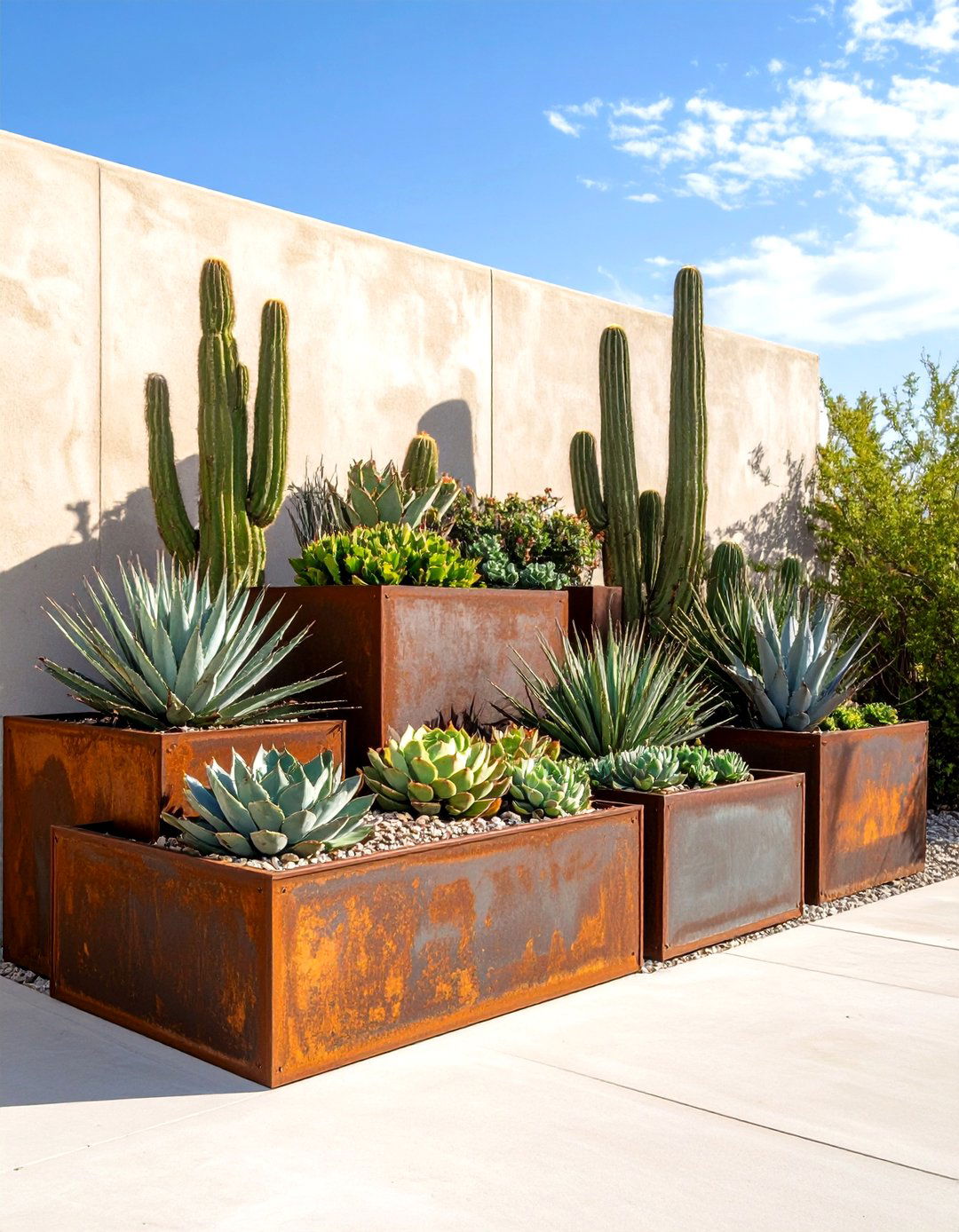
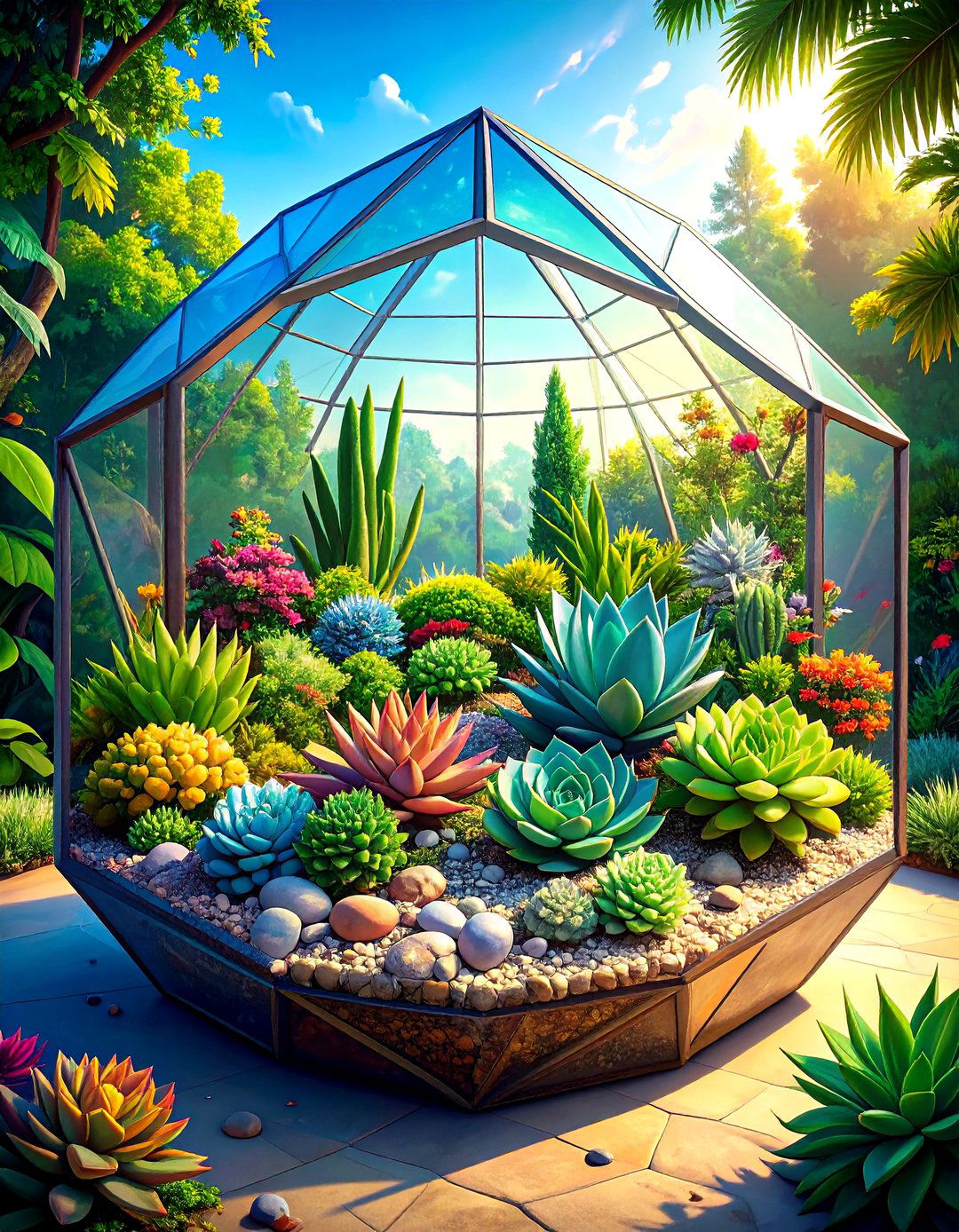
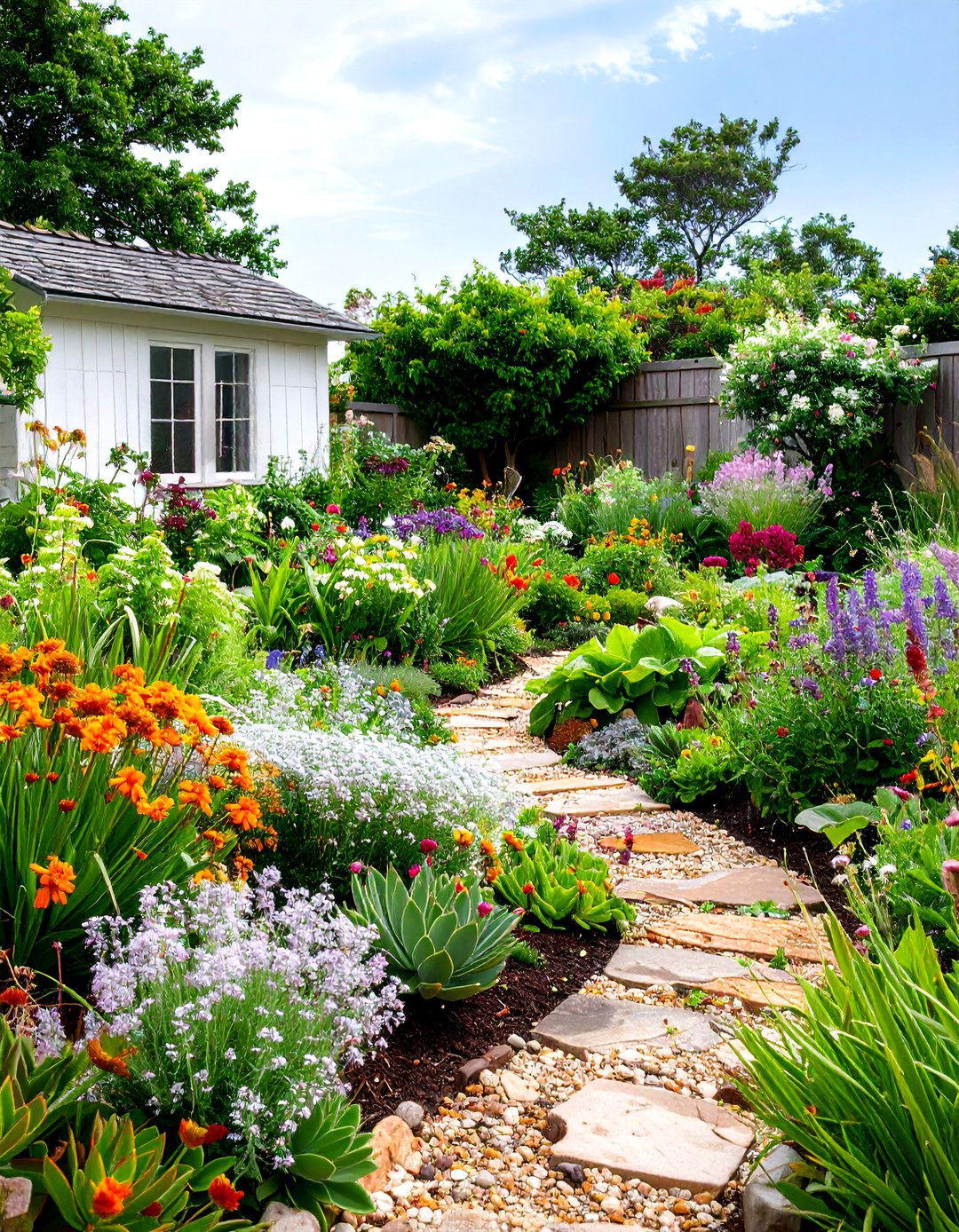
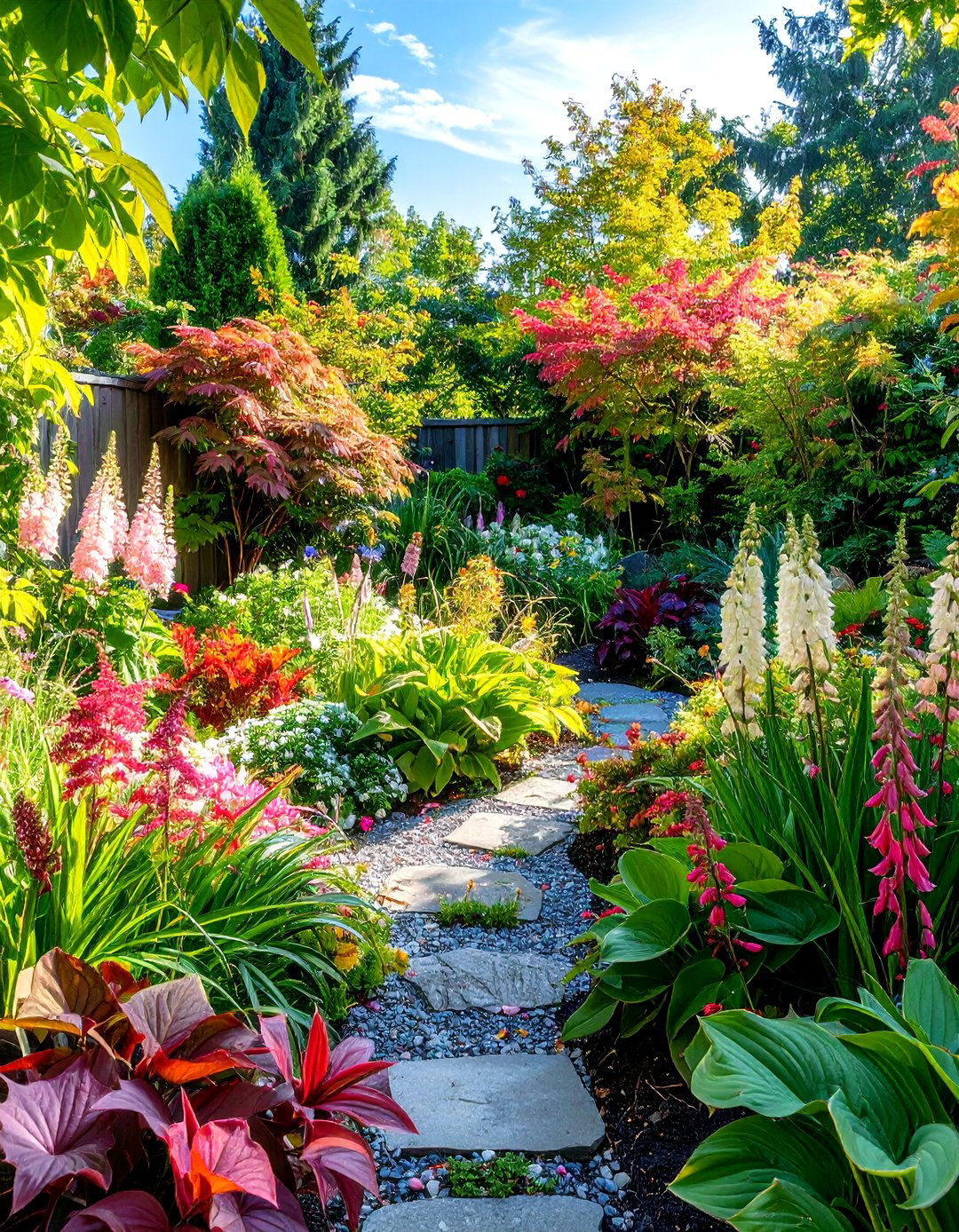


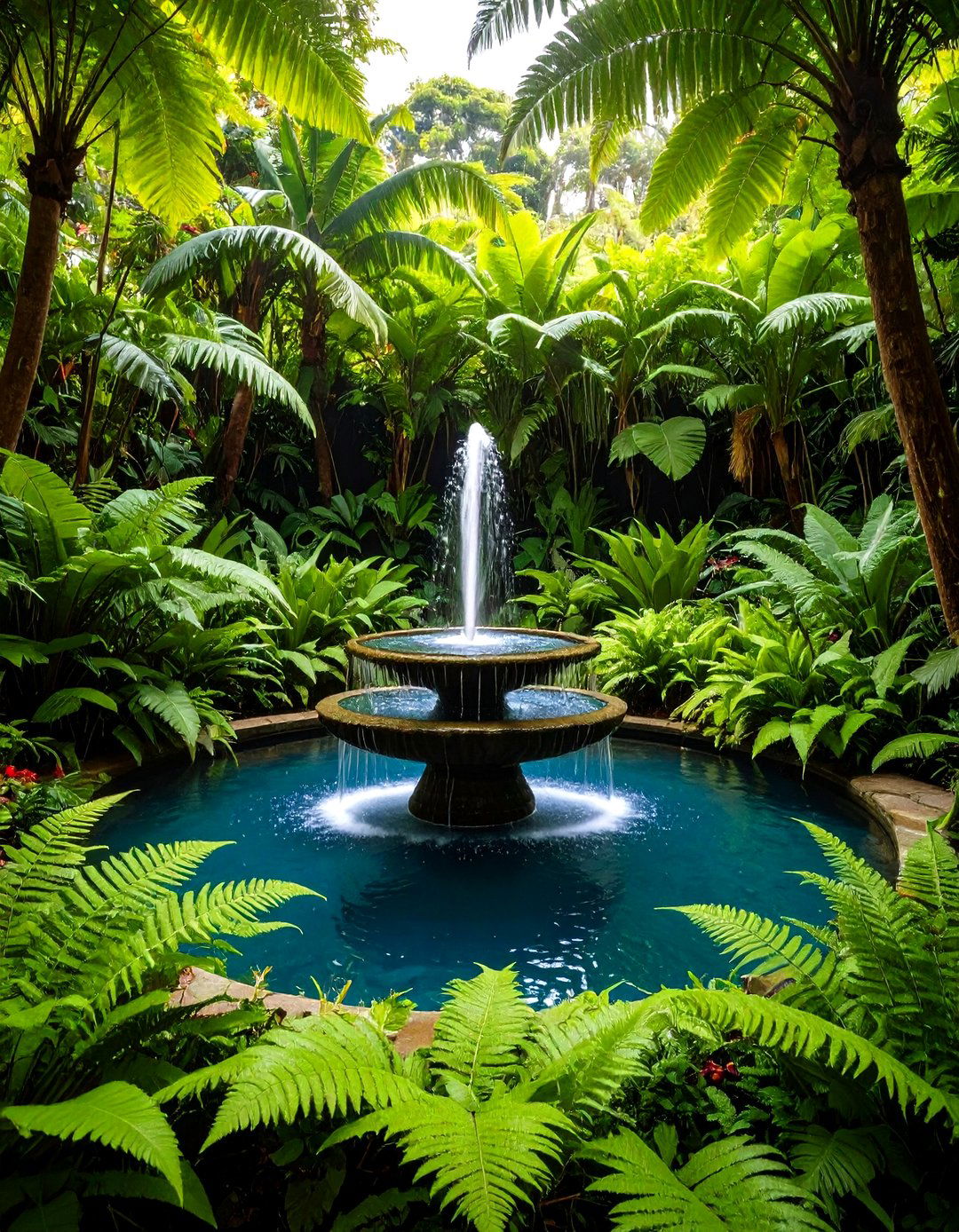
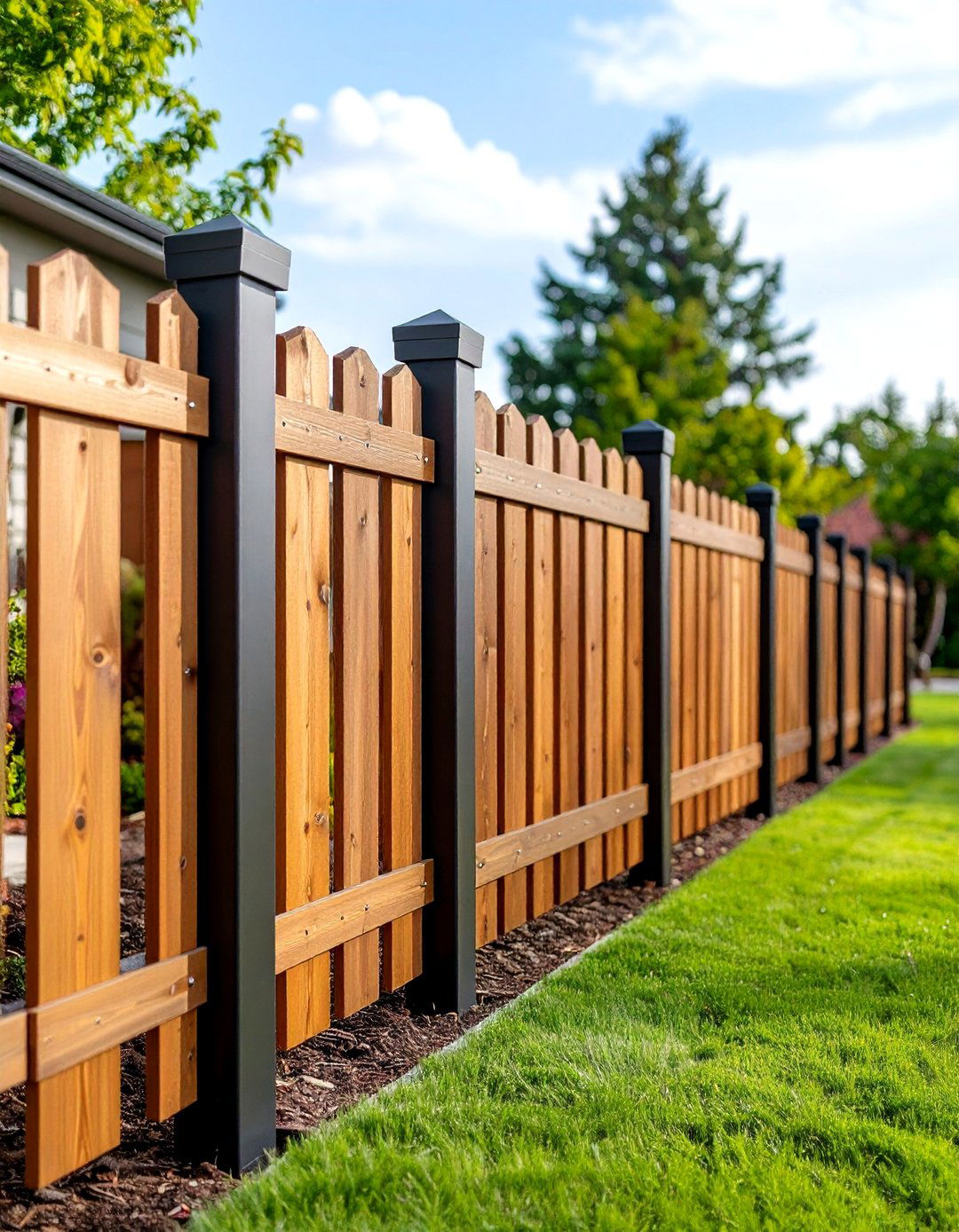
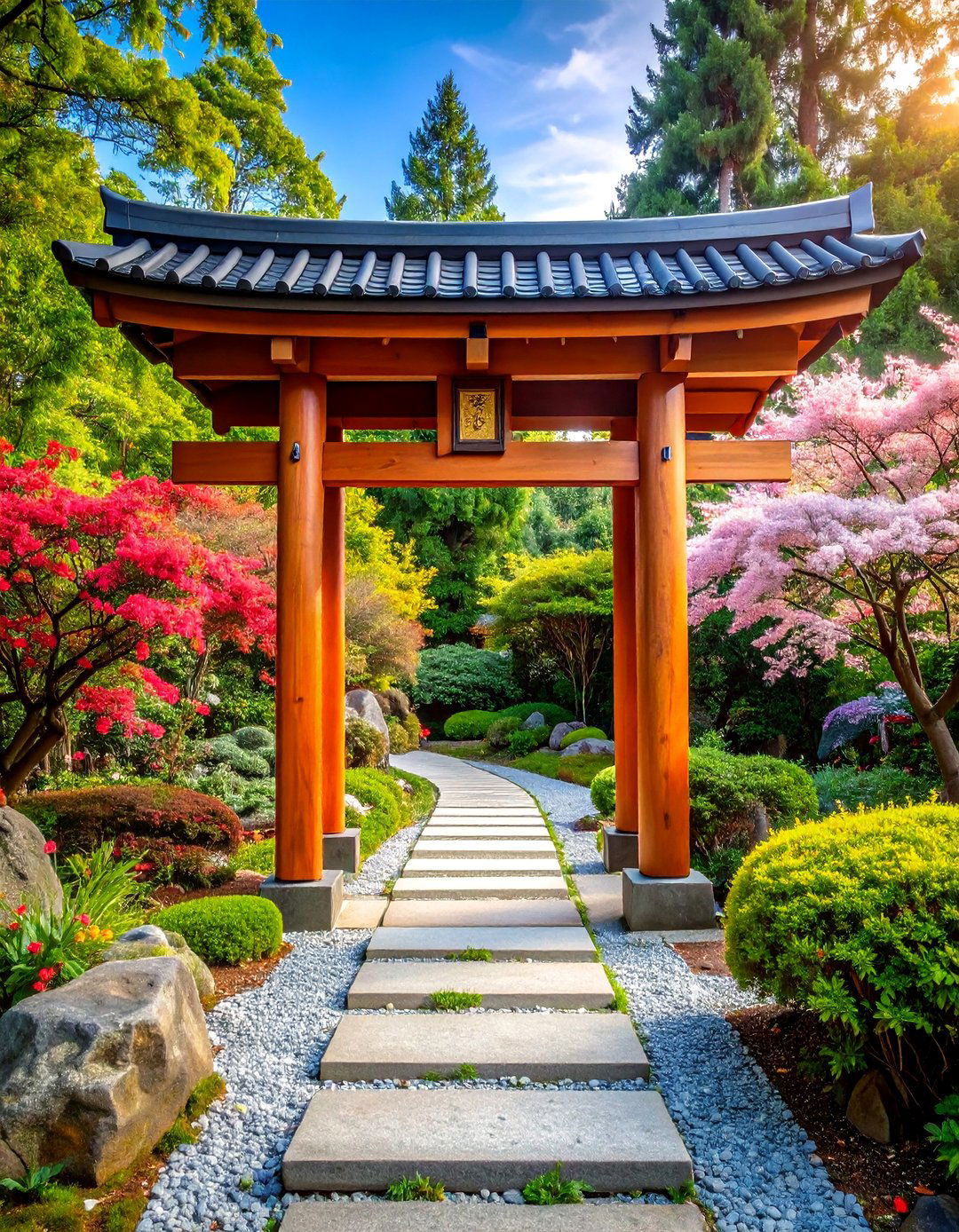

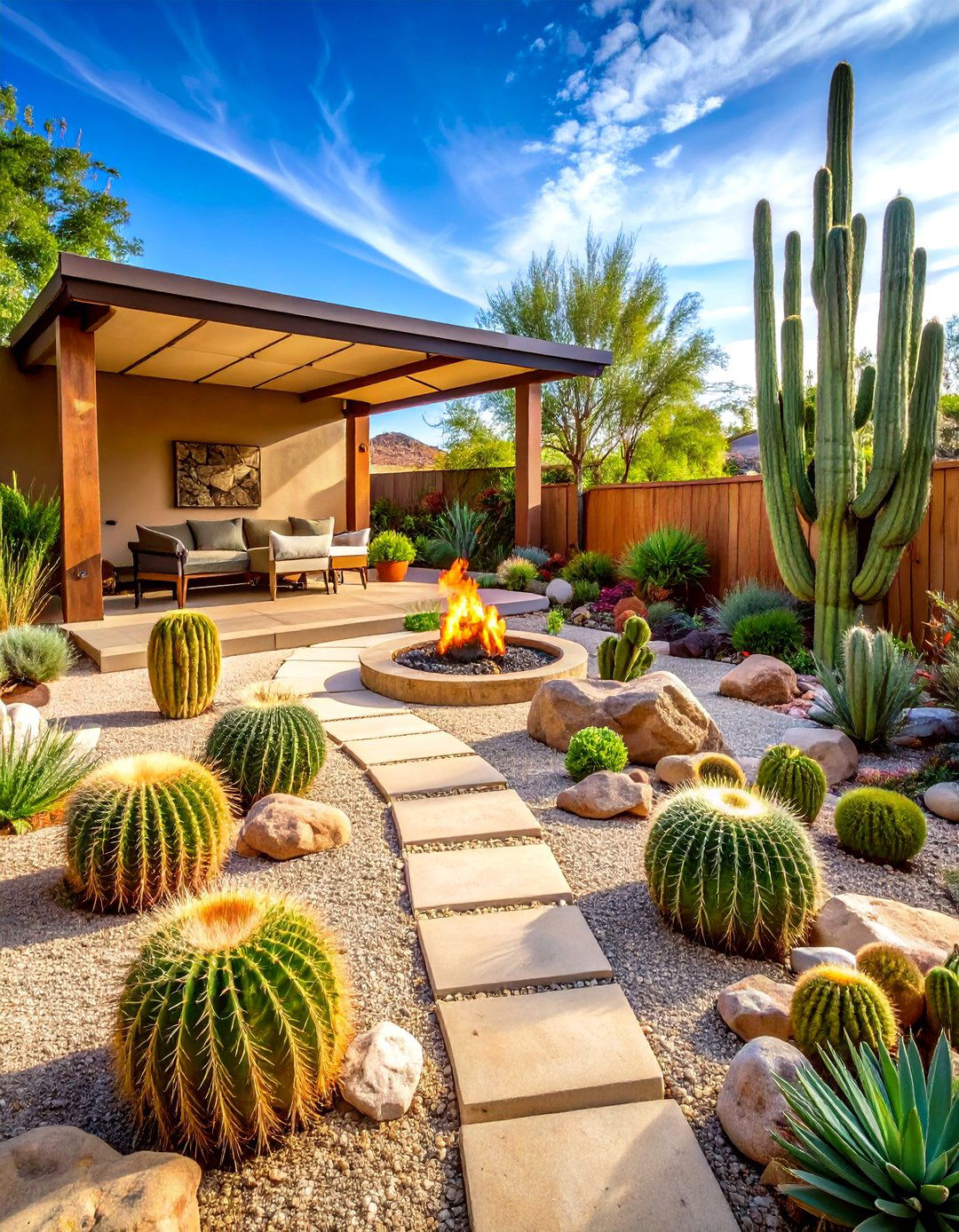
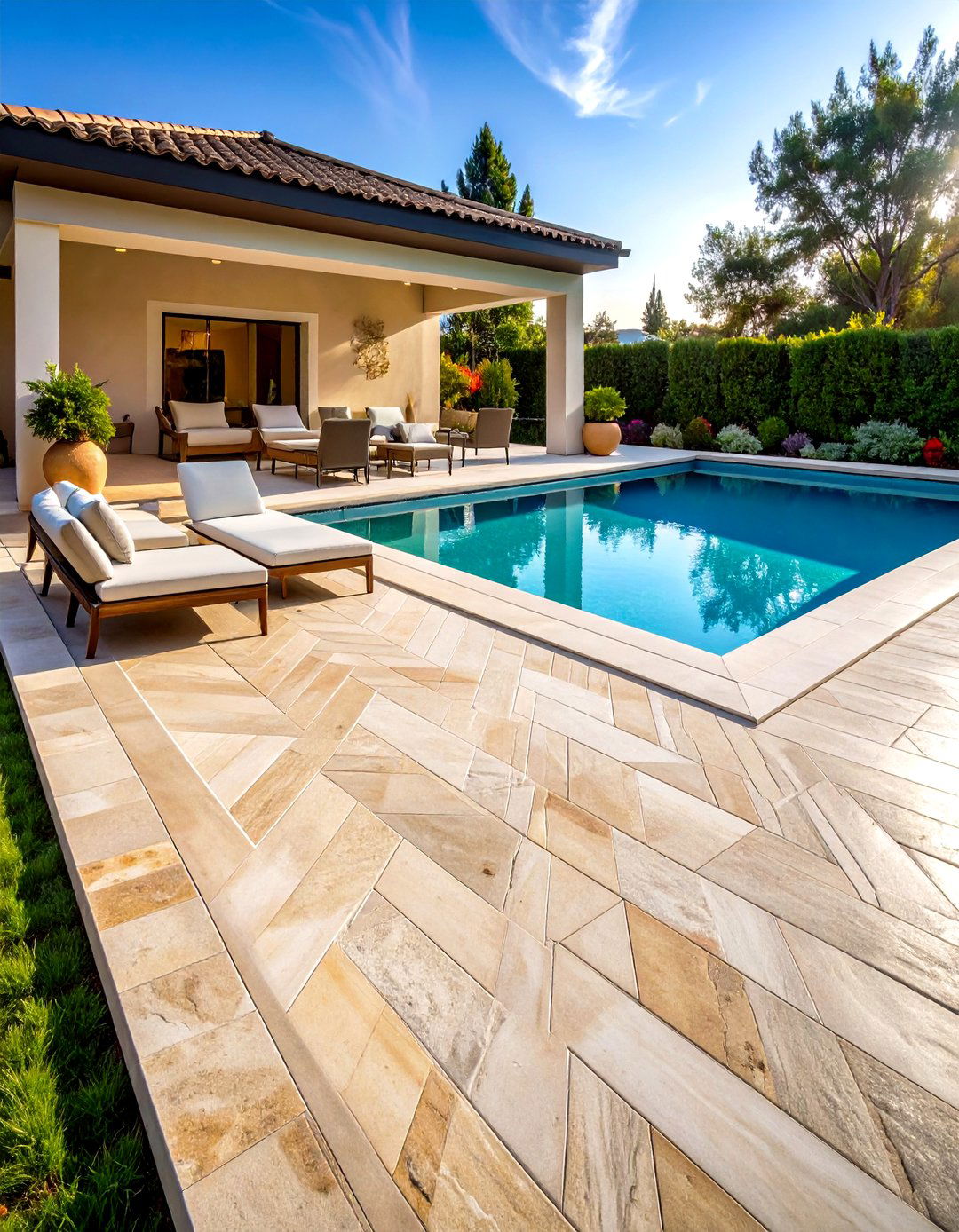
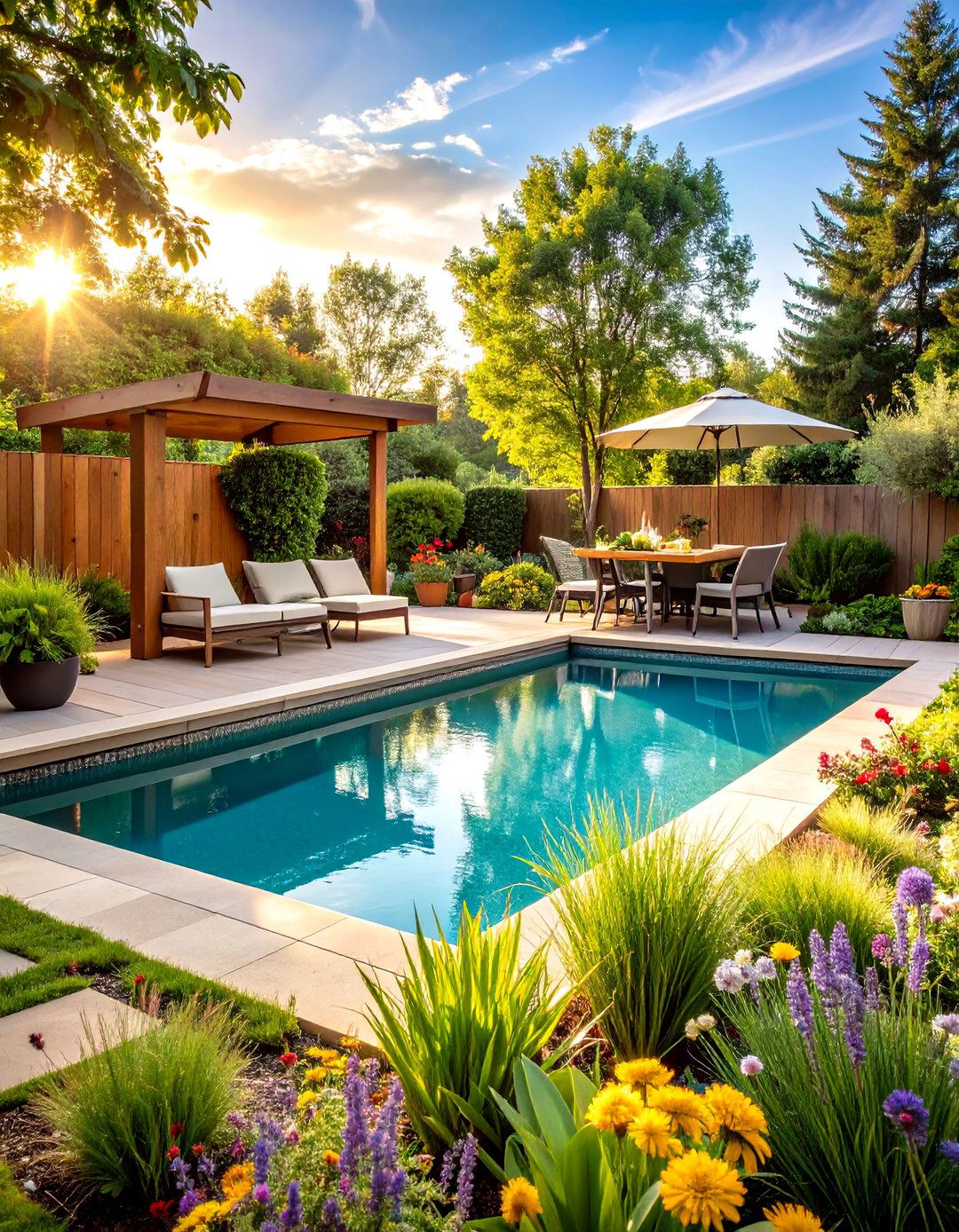

Leave a Reply